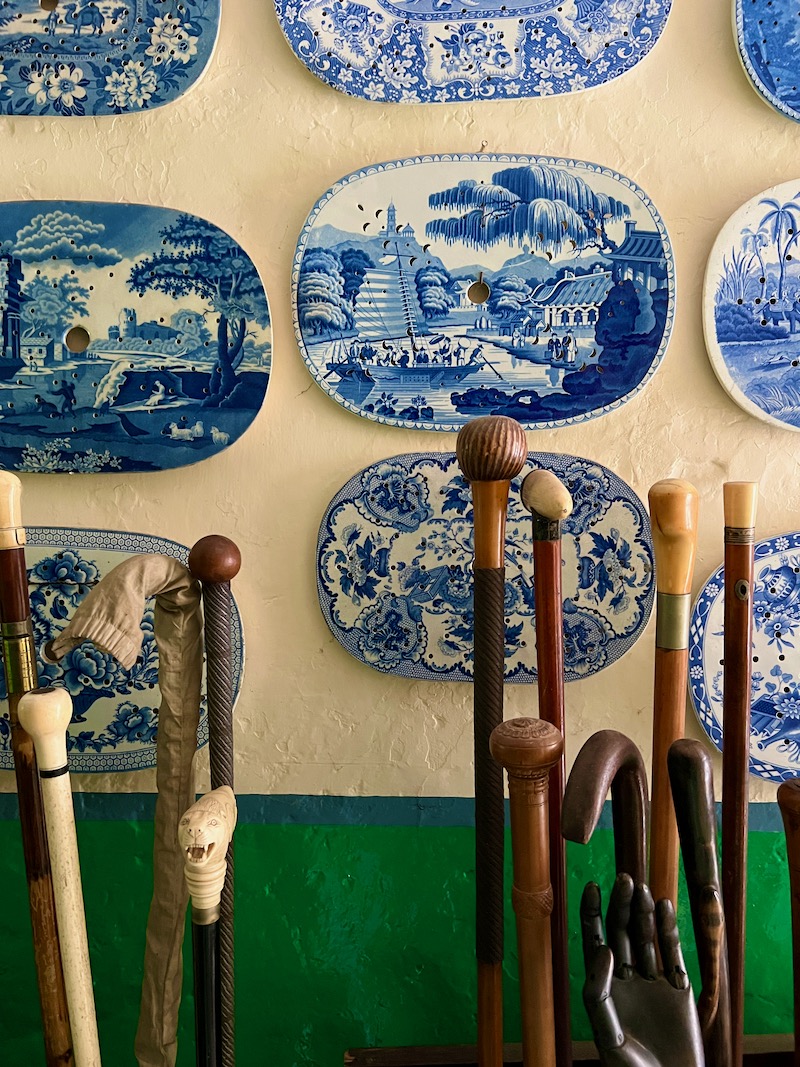
‘To start with this house had hardly any furniture. The men who moved us in were so shocked they left us the tea chests, so we used them for a year at least.’ This is the story of Gretchen Andersen, chatelaine of the famous Lacquer Chest antique shop @lacquerchest in Kensington Church Street, and the old house in Sussex that she found with her husband Vivian in 1959, told in her own words, mostly.
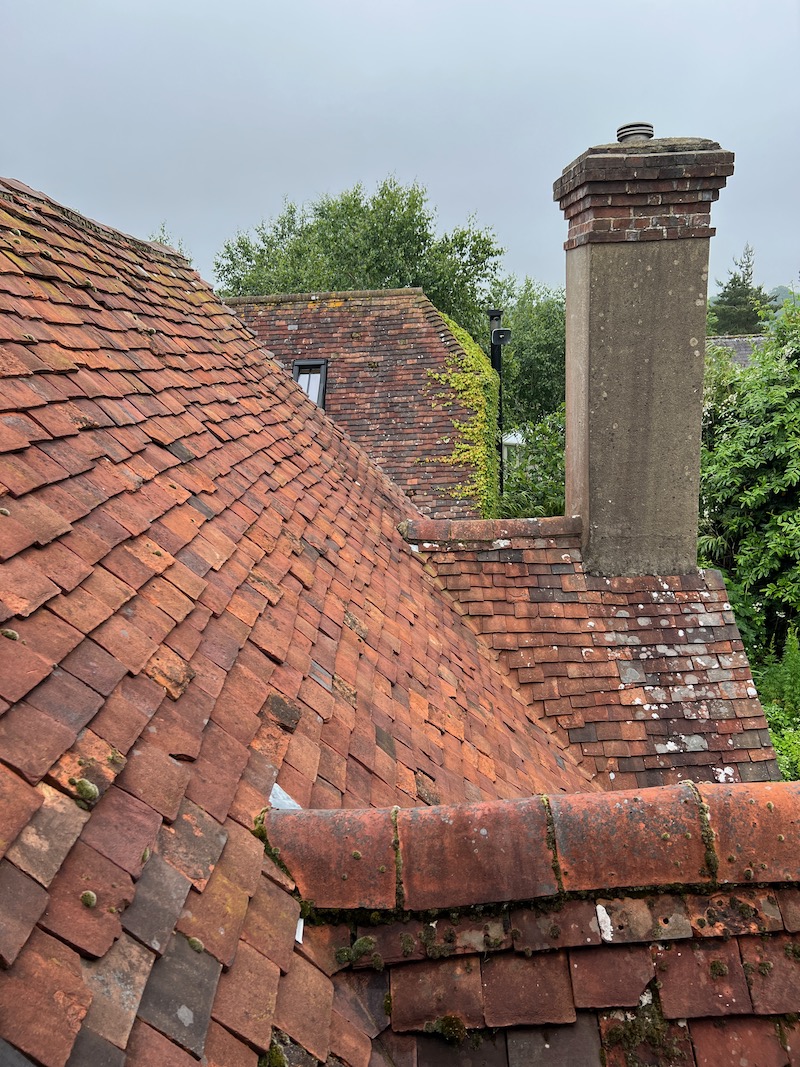
‘When we first moved in the end house was condemned , unfit for human inhabitation. There were brambles going inside it and a tiny bit of electricity and 3 outside loos – they’re still there. That house is very, very old, it was a hall house. We did a lot. It took us ages! We got it in September and by April 4th we’d moved in. In those days there were still proper builders who didn’t charge the earth.
Viv said, We’ve got to fix the roof! We used to buy the clay tiles second-hand.’
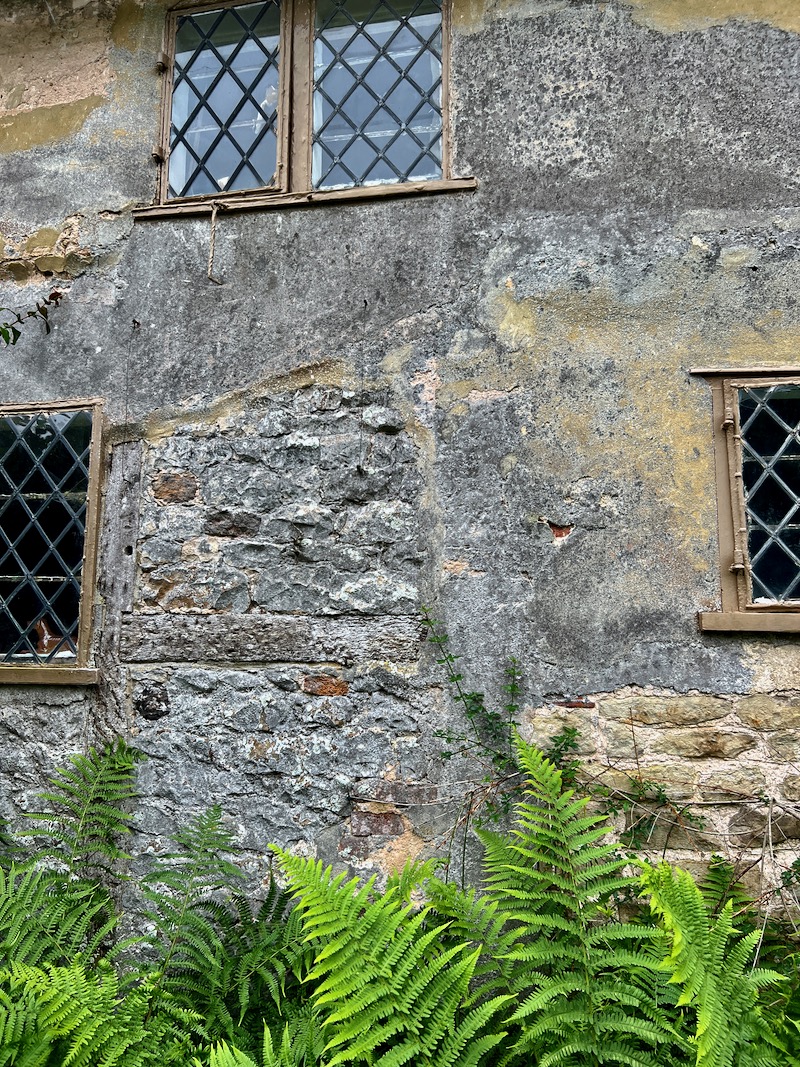
’‘It had been part of the Petworth estate since the C13th, 1365. Three different families had lived here but only Mr. Francis was left when they printed the auction catalogue. Most people hadn’t wanted this house because it had a tenant – then he fell off his bicycle and they gave him a one of the council houses.
When the rates came, it was called Old Manor Farm, but it wasn’t properly recorded in the Petworth archives. Then the archivist discovered that this was in fact the manor. It used to have 300 acres.’
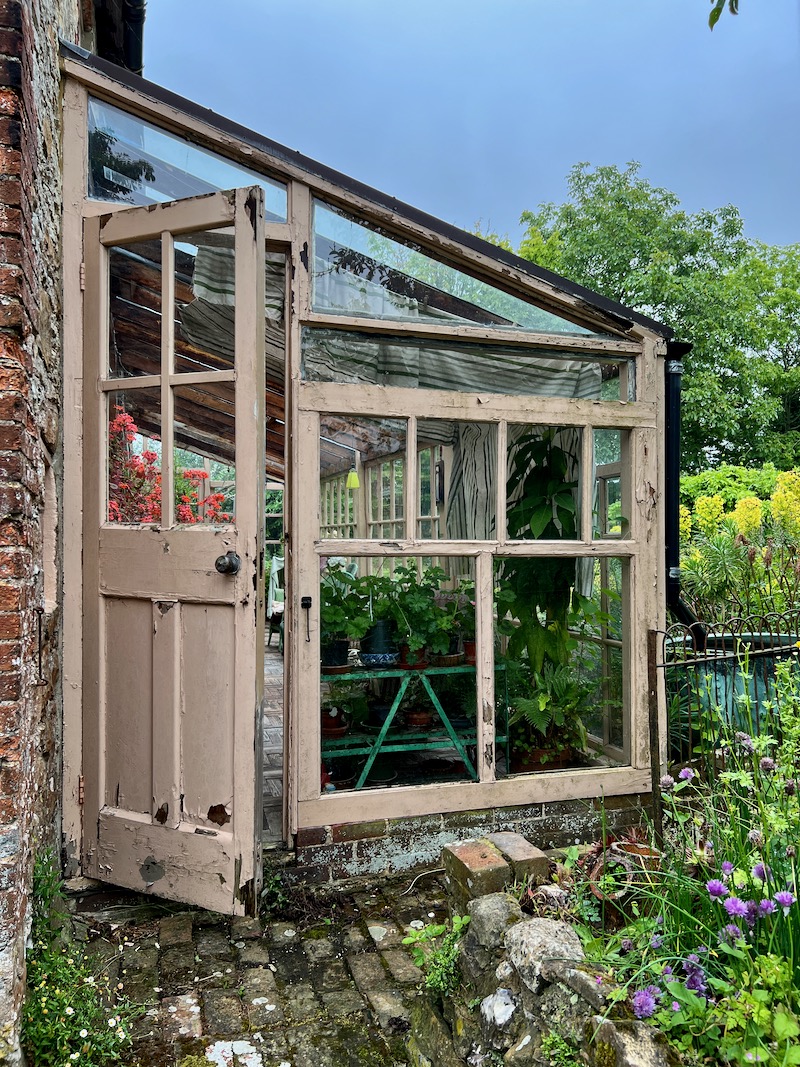
‘We’d just had Emily. We were horrified when we rang a hotel and they wouldn’t have us because we had a baby! Viv said, We’ll have to buy our own country house. We had a little money because I had this bad car accident and got compensation. We rushed around and decided we’d spend £700 . I went to bid at the auction in a marquee at Petworth House but it went for £1,700! I remember being terrified, but Viv said, I’m sure we’ll manage. We had the £700 in cash, we’d sold out house in Hammersmith and we needed a bridging loan but we couldn’t get one – and Ove [Arup, her late husband Viv’s employer then] lent us the money, sweet man.’
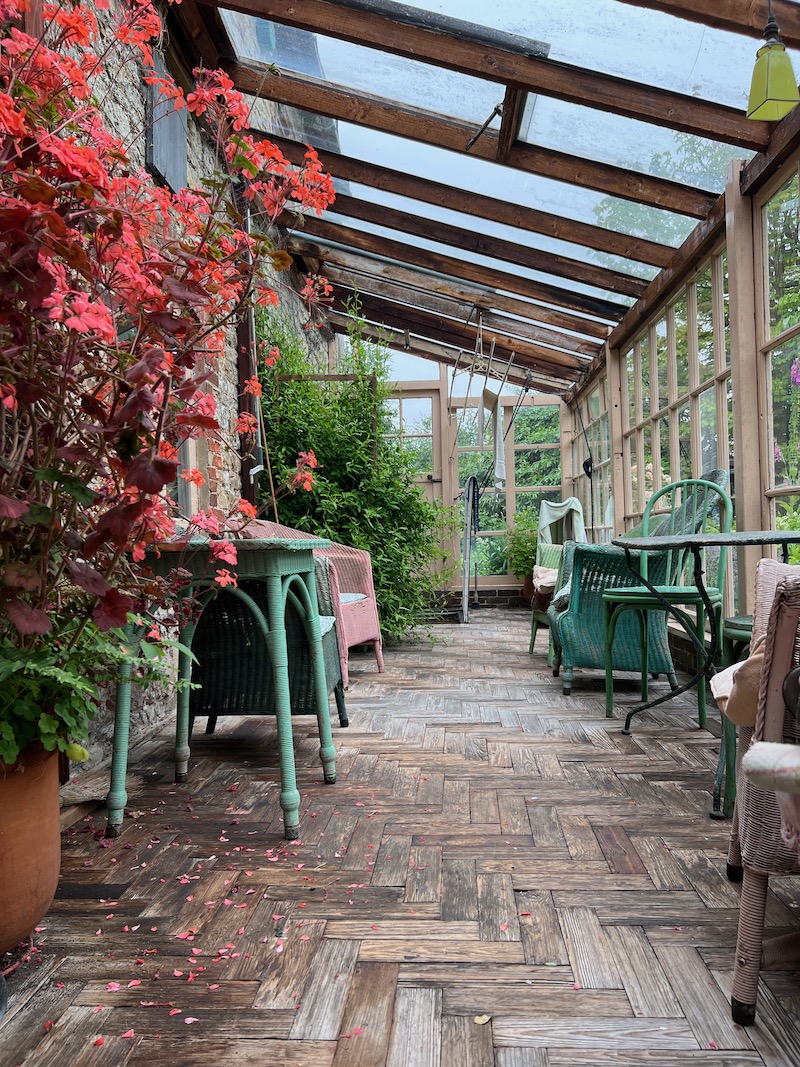
The conservatory running along the back of the house was built from glazed partitions that Viv salvaged from a printers, the West Sussex Gazette in Arundel, along with the parquet floor. A wren is nesting in the clematis now.
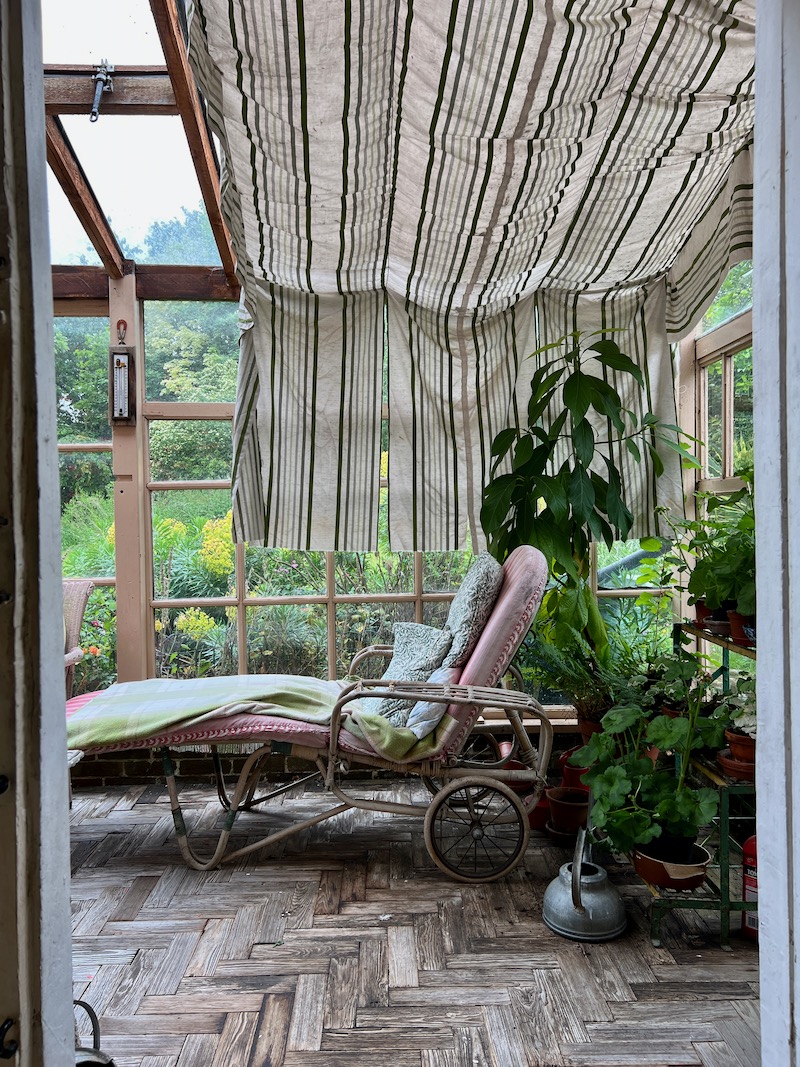
Cane daybed in the Conservatory
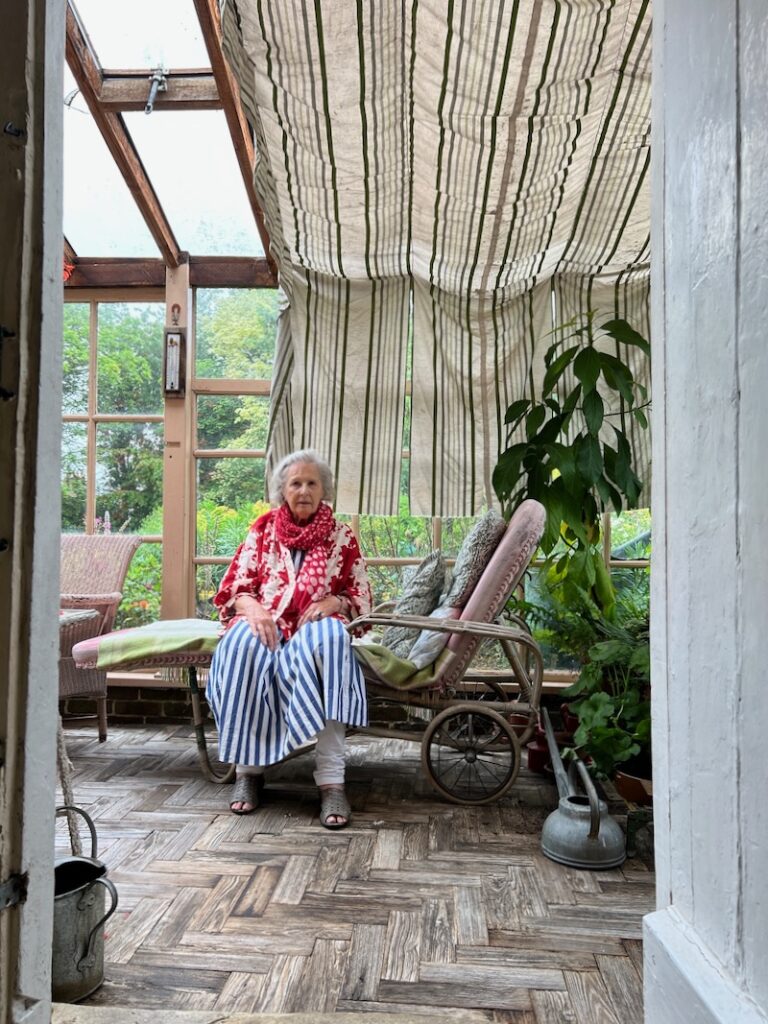
‘Mr Clare who lived down the road was very good at growing dahlias – I used to talk to him for hours, he told me everything – and I never wrote it down! He was said to be the illegitimate son of Lord Leconfield. He’d be about 140 now.’
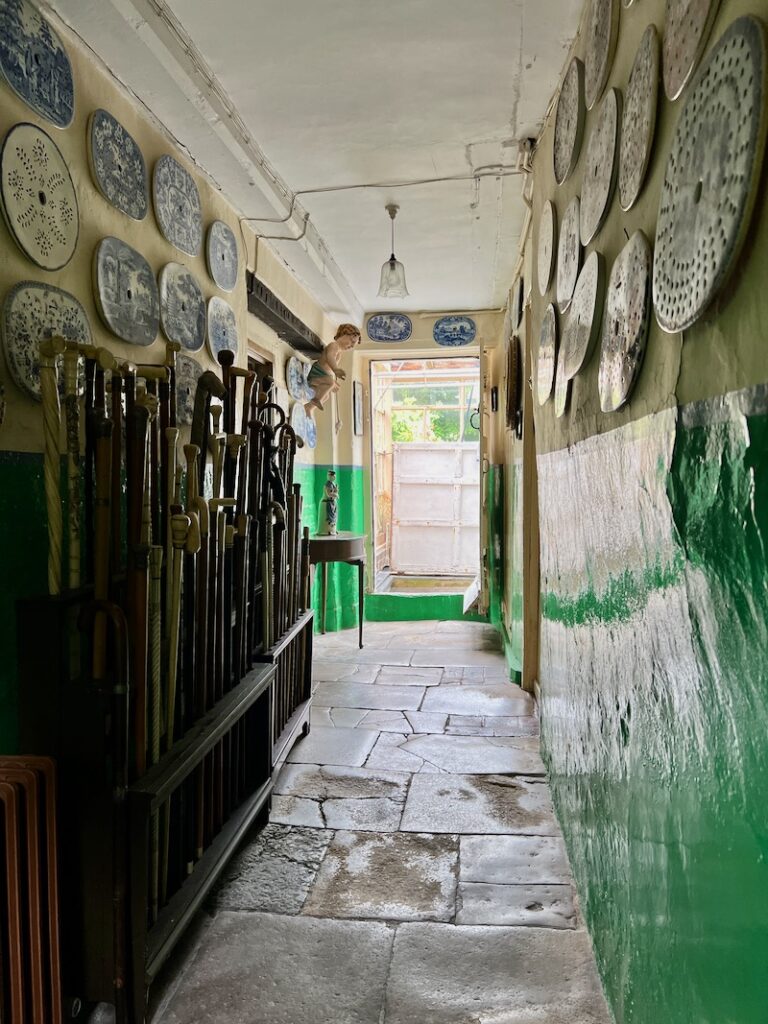
‘A wonderful man, Mr Wells, used to live in this house with his aunt when he was a boy. And he was terribly fond of it. He used to come and paint the rooms when we were in London. Quite often, he painted the wrong room the wrong colour, because he hadn’t heard properly! I was so sorry when he gave up painting.’ Viv’s collection of C18th and C19th walking sticks.
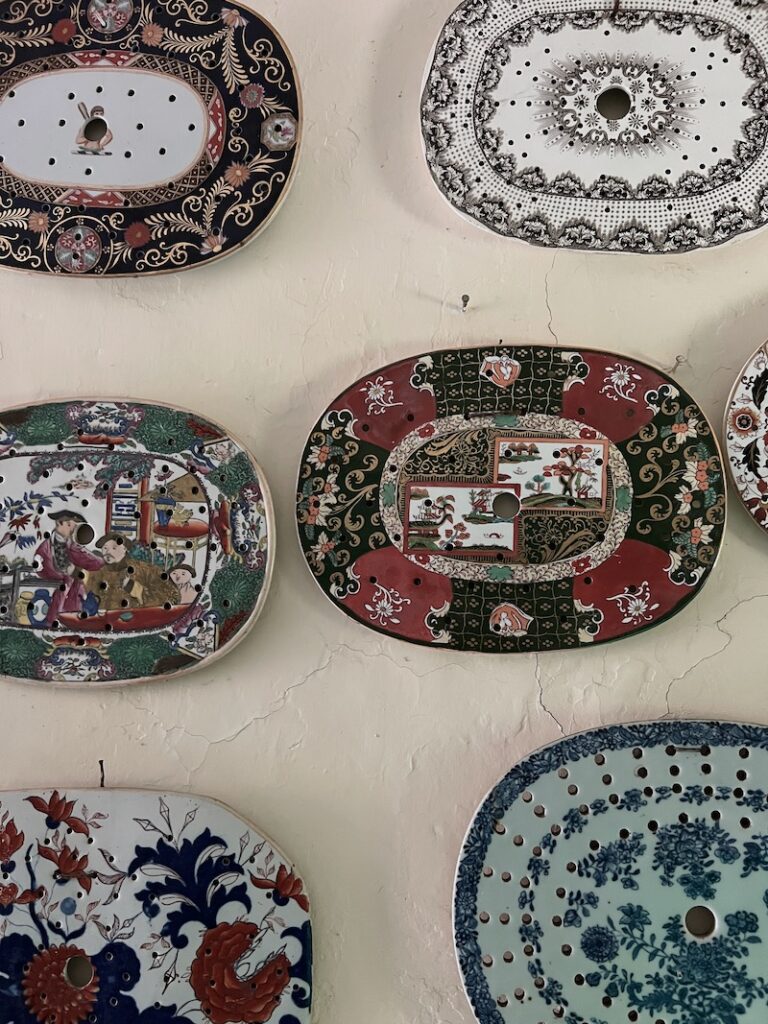
Georgian and Victorian ceramic drainers
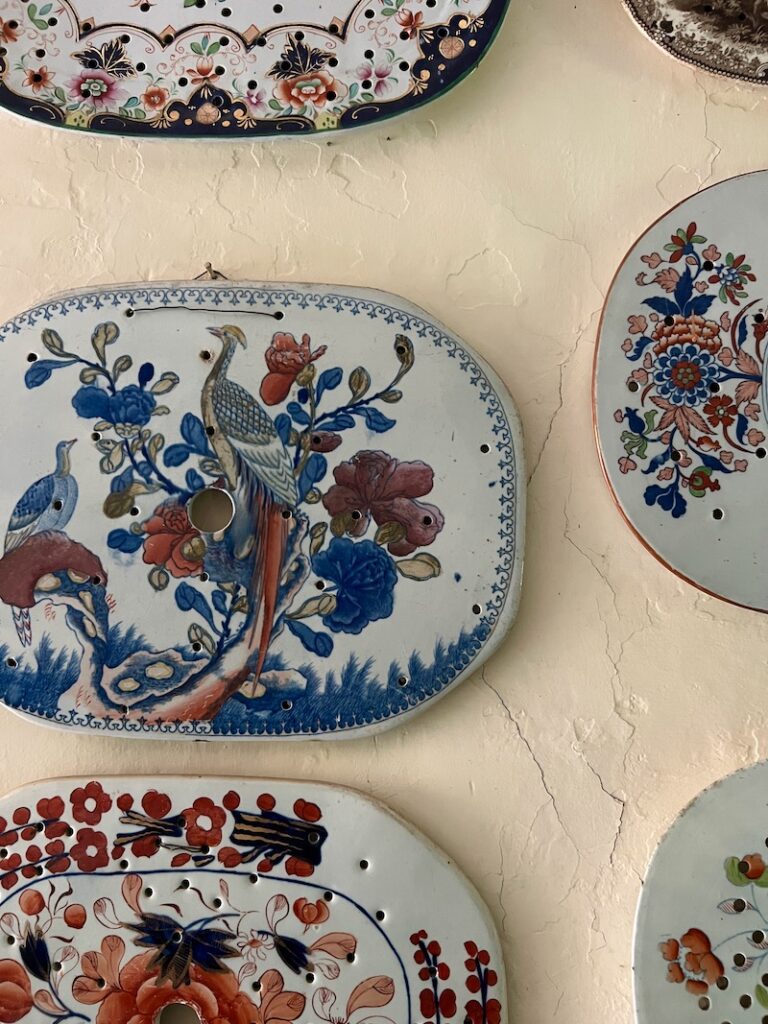
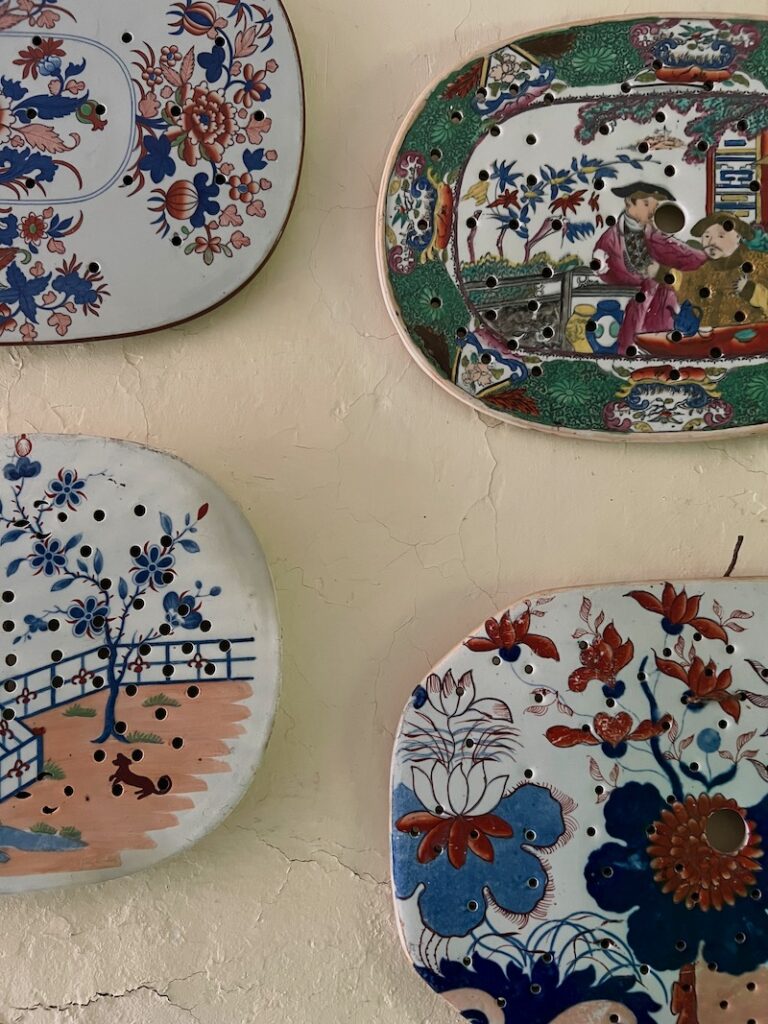
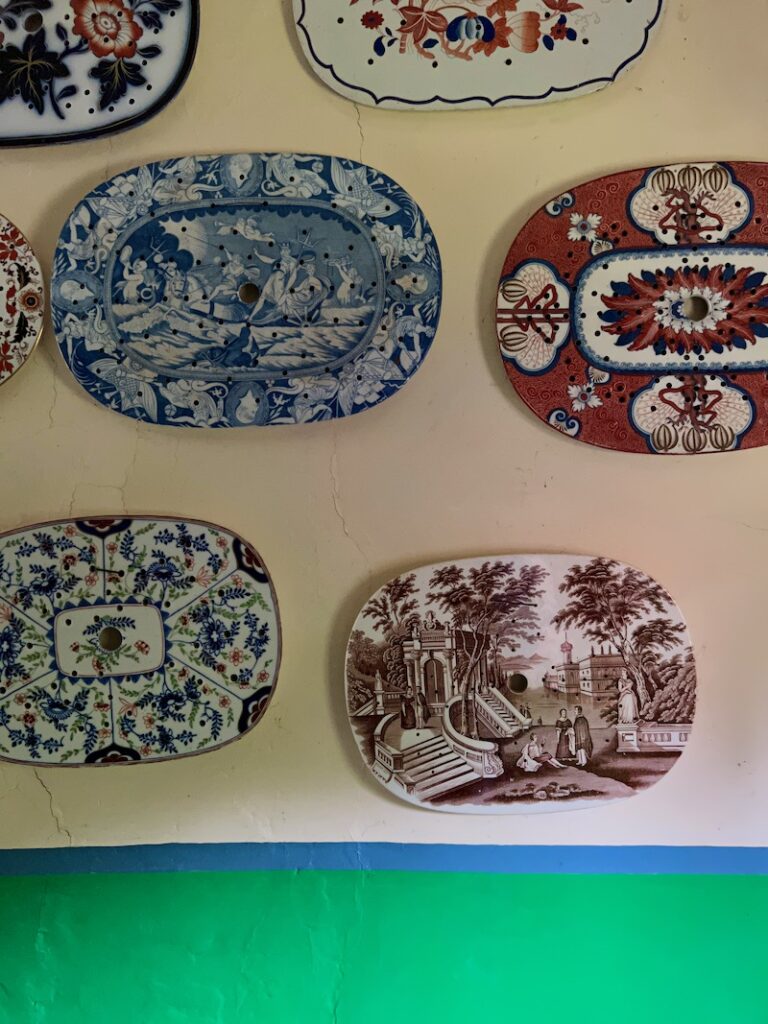
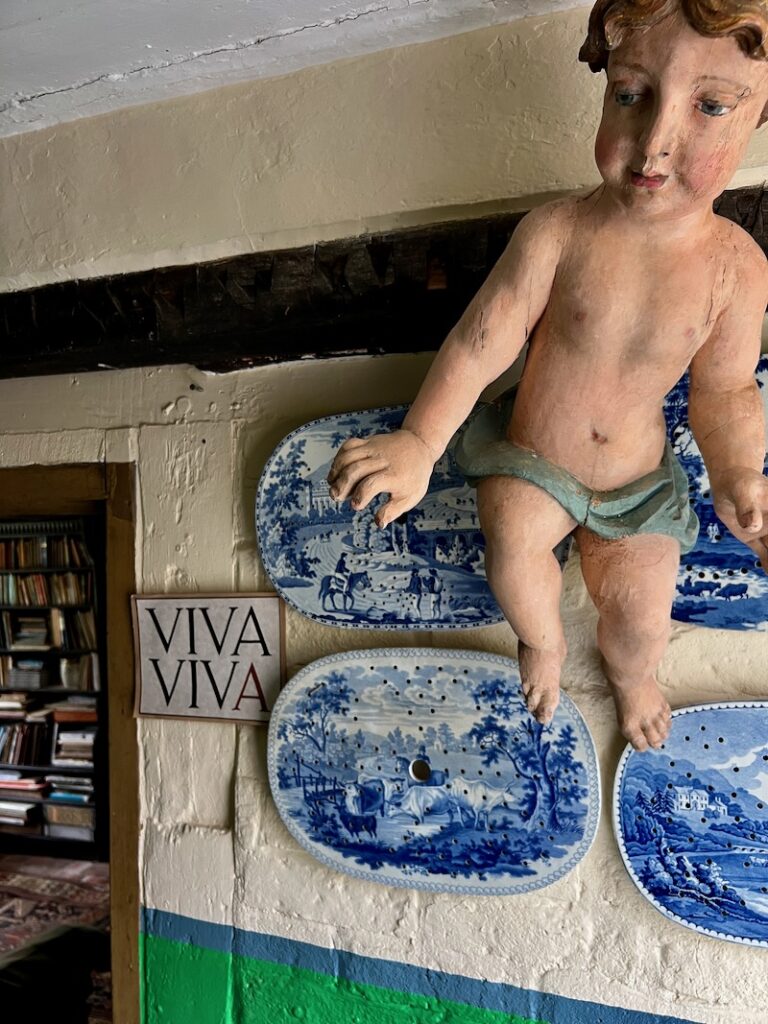
ecclesiastical putto, child-angel
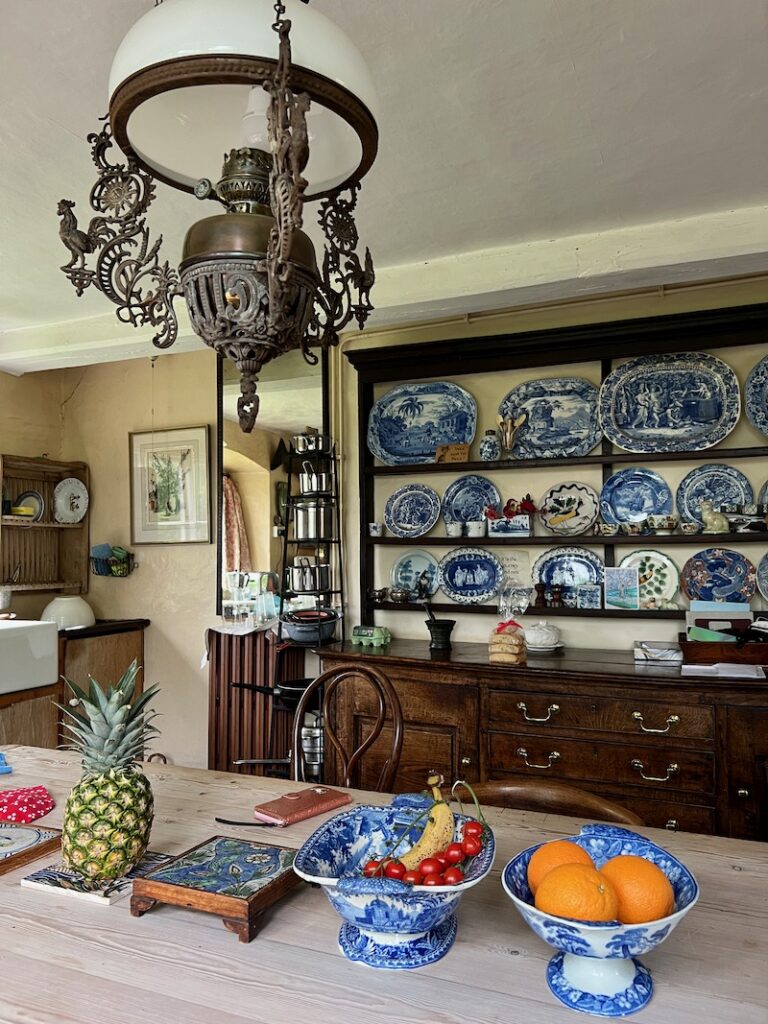
‘This kitchen is very 1970s. It has an oil lamp hanging over the kitchen table and a dresser full of china.’
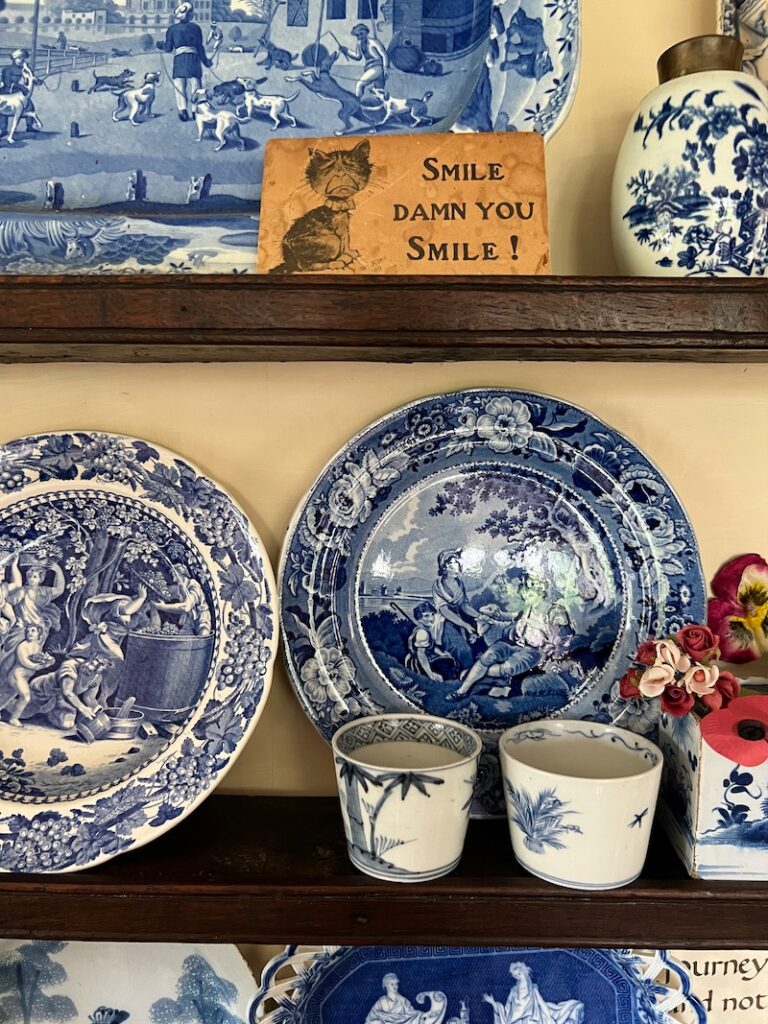
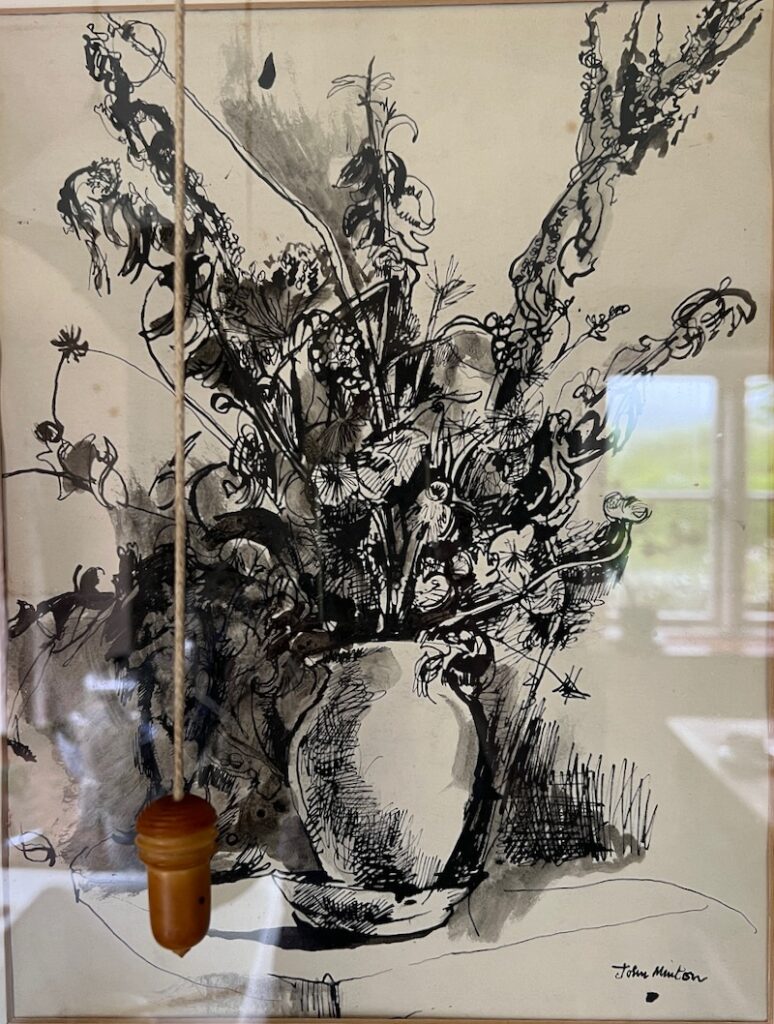
I’ve always liked John Minton, in this one he’s drawn a tiny little nude man.
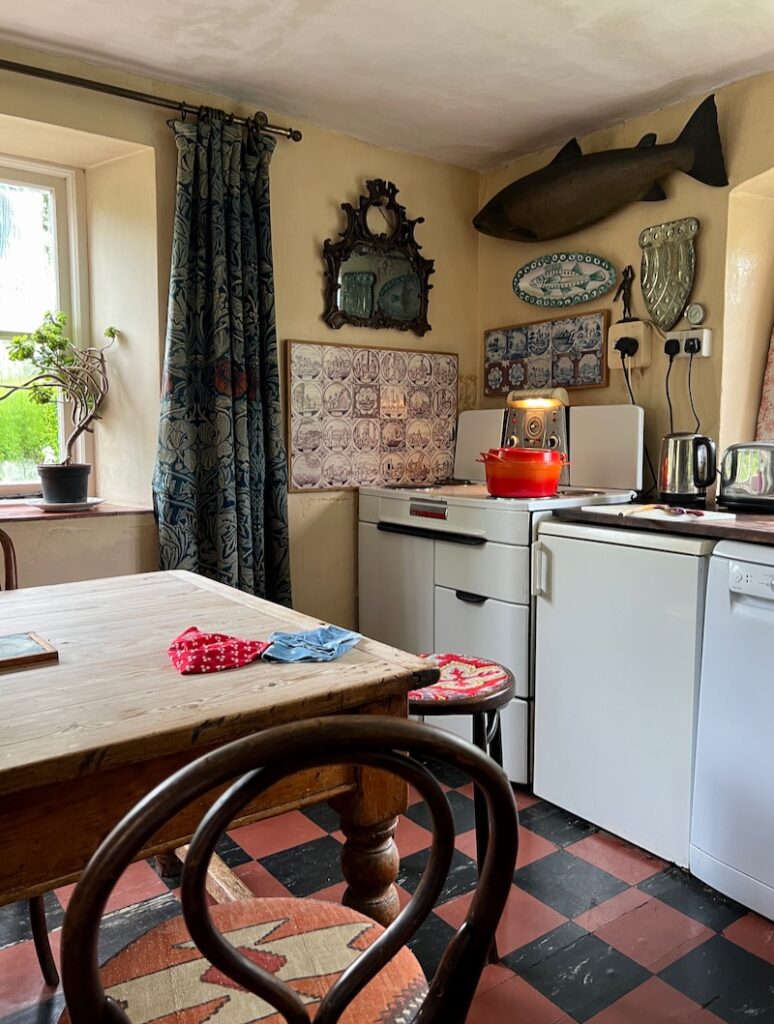
“They were rebuilding a whole town down Hampshire way – Basingstoke. Everything was being chucked out by the builders.
This was the baker’s table. Viv used to go every week to the tailors, the bakers, and take everything. I was an obsessional cook. I used to make huge meals for far too many people, so my old friend and neighbour Barbara who was 70, Viv, and me, we got this huge table in through that window.’
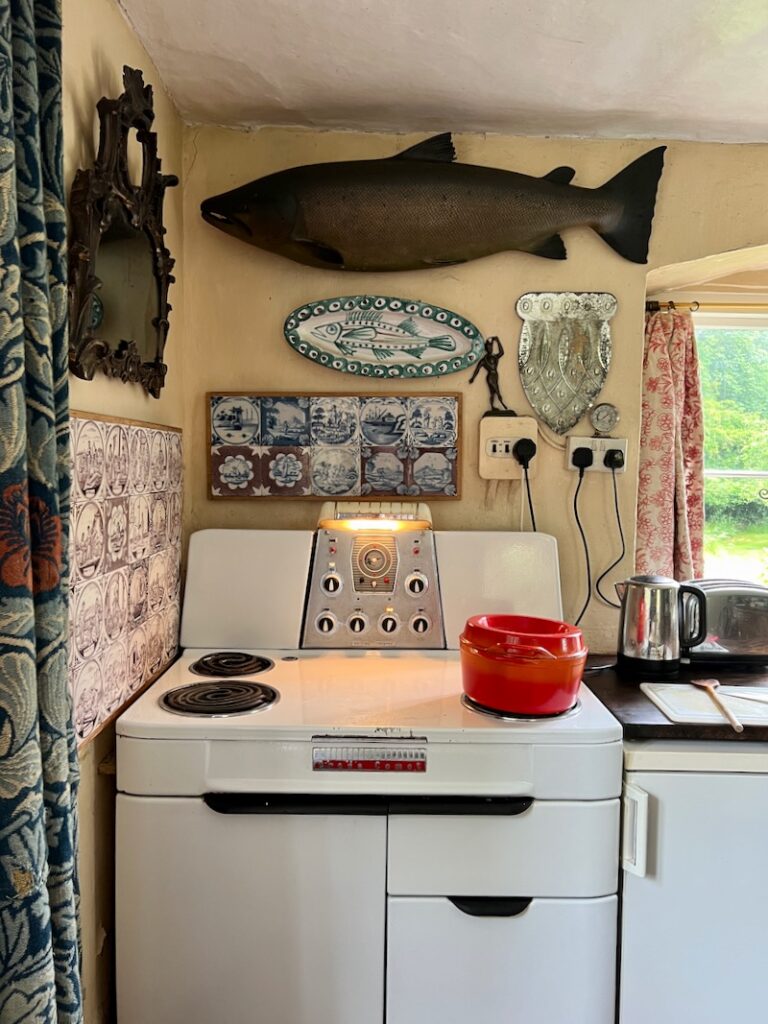
Delicious lunch, cooked by photographer @andersenemily_photography, Emily Andersen, Gretchen’s daughter, The 1956 Creda cooker was bought second hand for £18 in the 60s, above it is the single remaining carved wooden Salmon of 26 that were found and sold in @lacquerchest by Viv
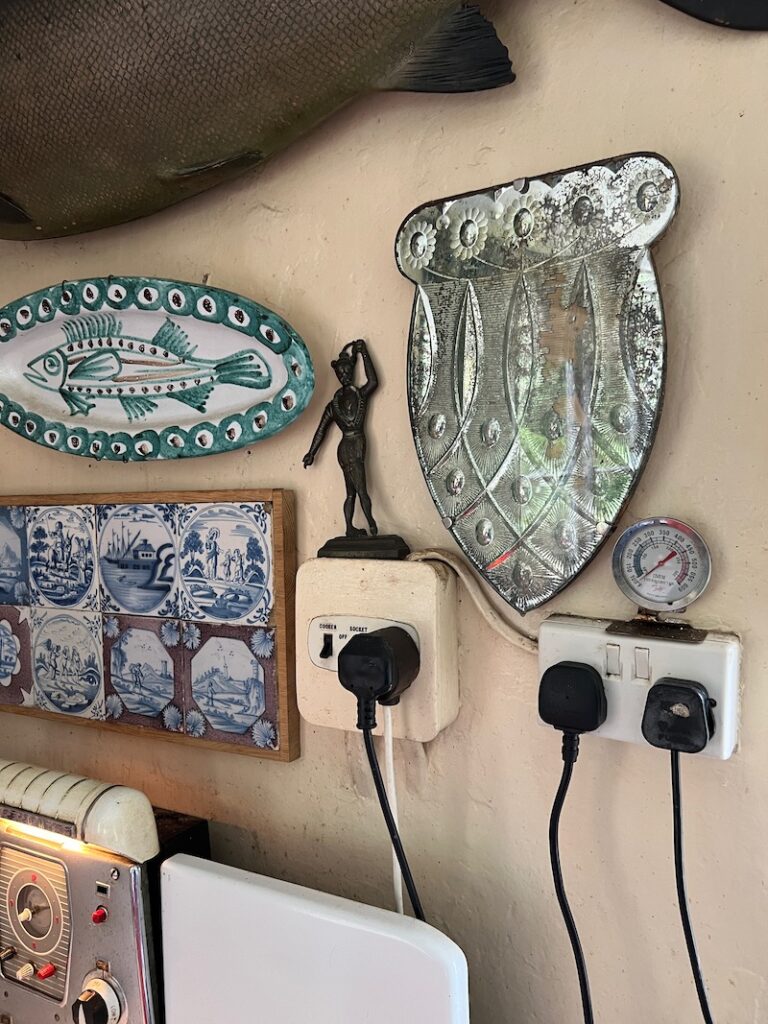
‘At the tailors there were hundreds of breast pockets with crests on, for little boys school uniforms. My mother sewed them together and made clothes for all the children!’
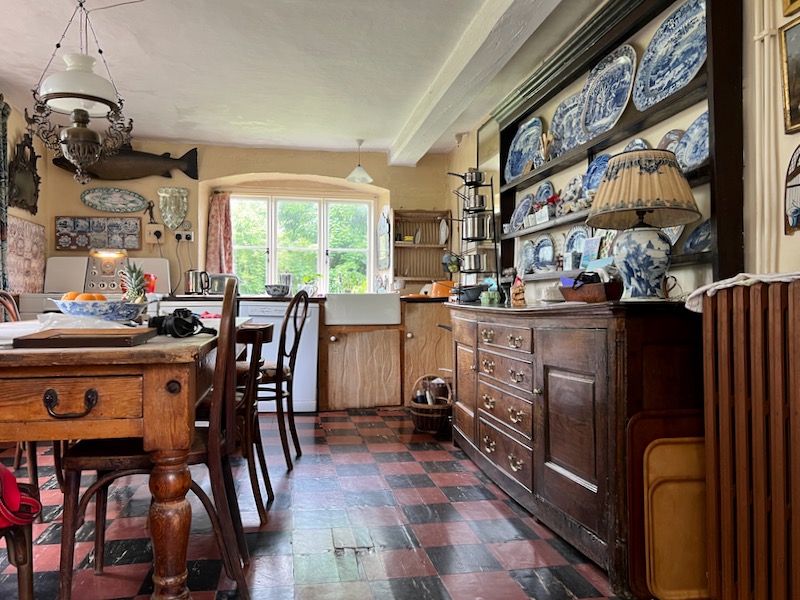
‘When we were here in the summer we’d have a list of jobs, Toby and I (not so much Ben, he was too little) – Polish the table, wash the windows, saw the wood! We didn’t have a television set and we used to go over there to the neighbours to see Dr Who.’ – Emily Andersen.
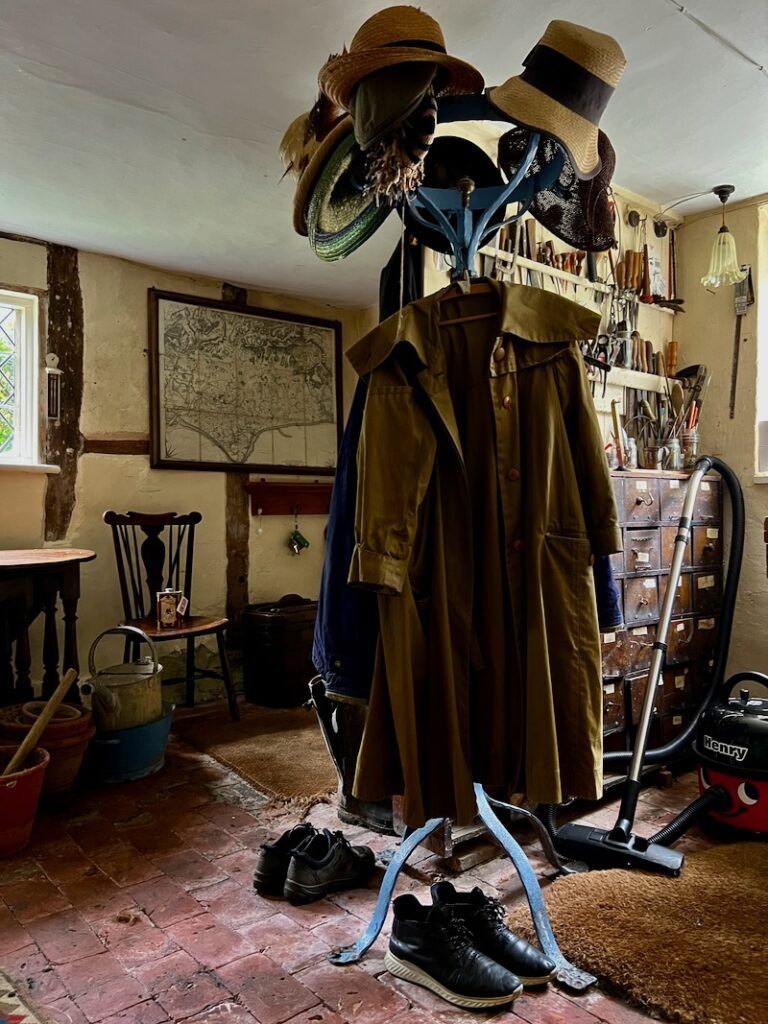
‘A dealer in Pulborough was very supercilious. he called us Cobweb Castle.’
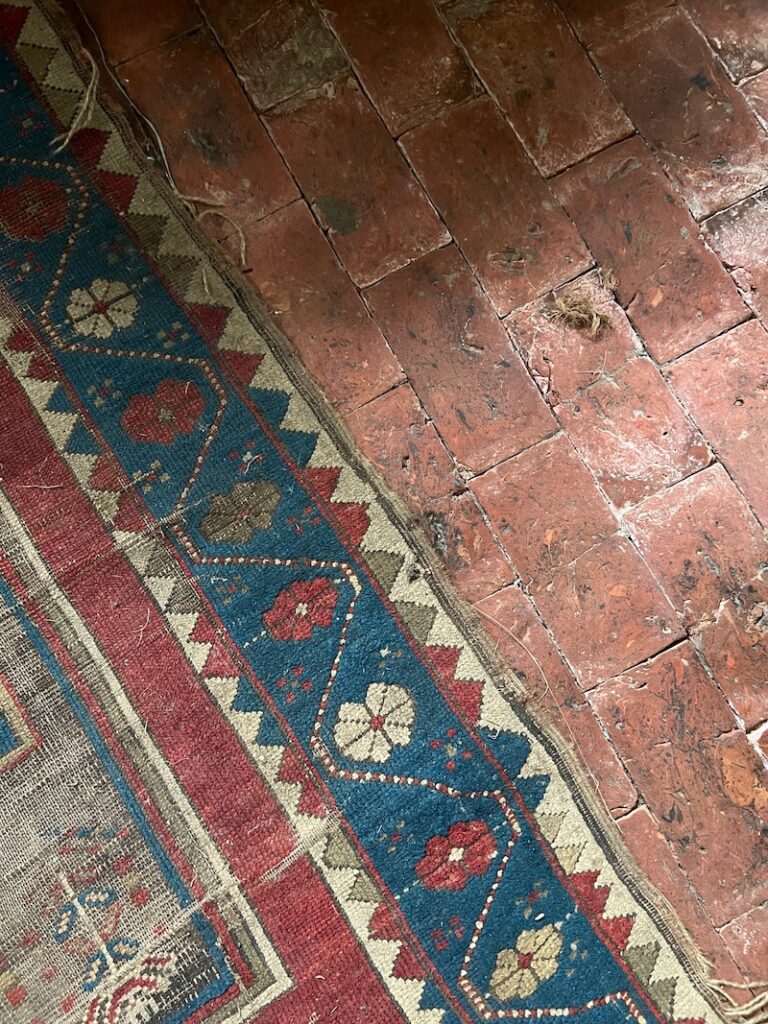
rubbed brick, entrance hall floor
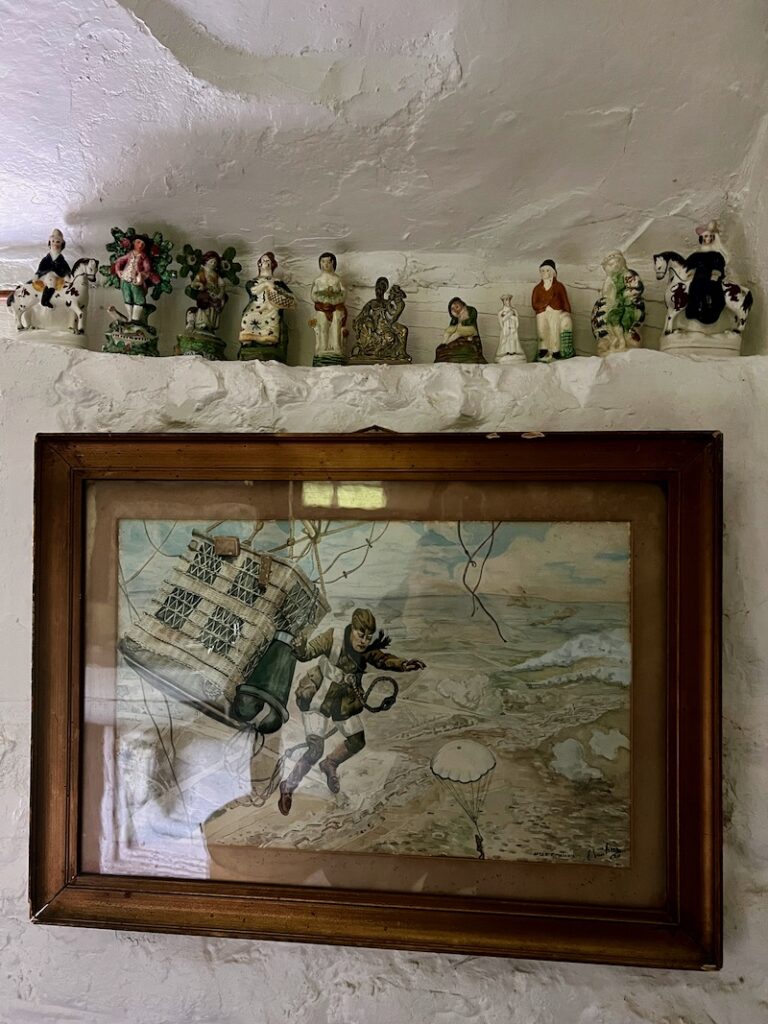
downstairs lav, collection of foundlings
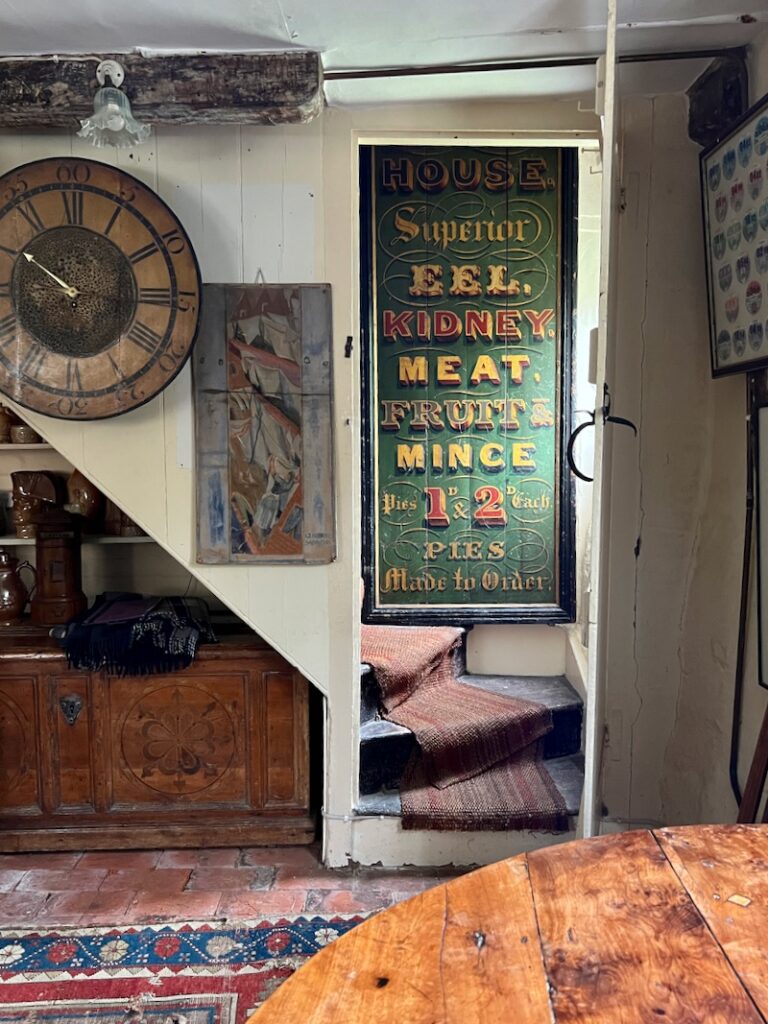
Pie shop sign, little back staircase
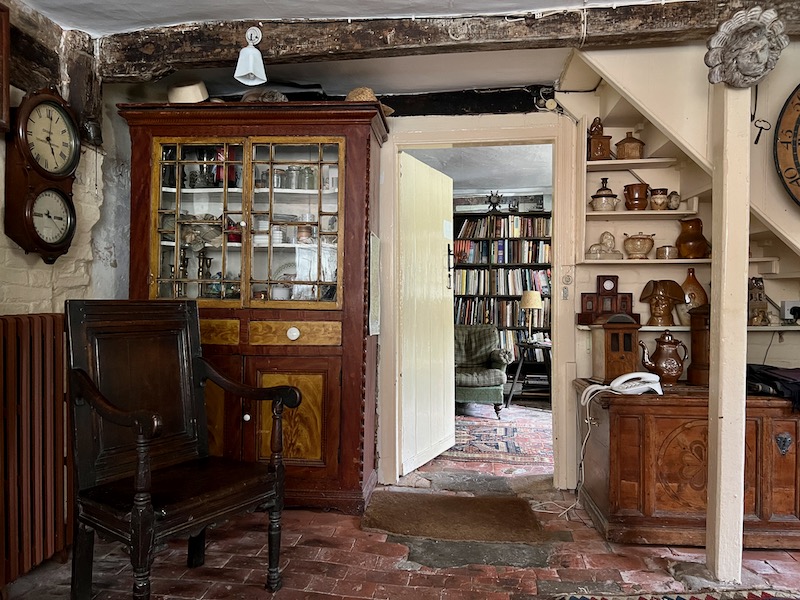
Salt-glazed pottery in the entrance hall
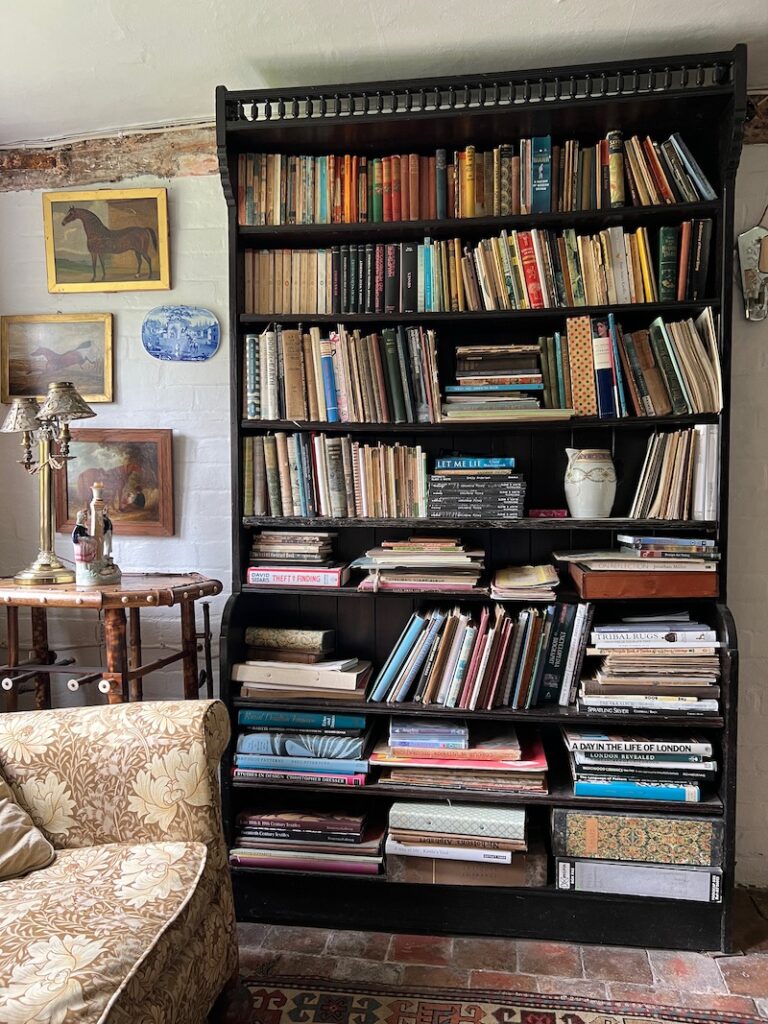
little study cum sitting room
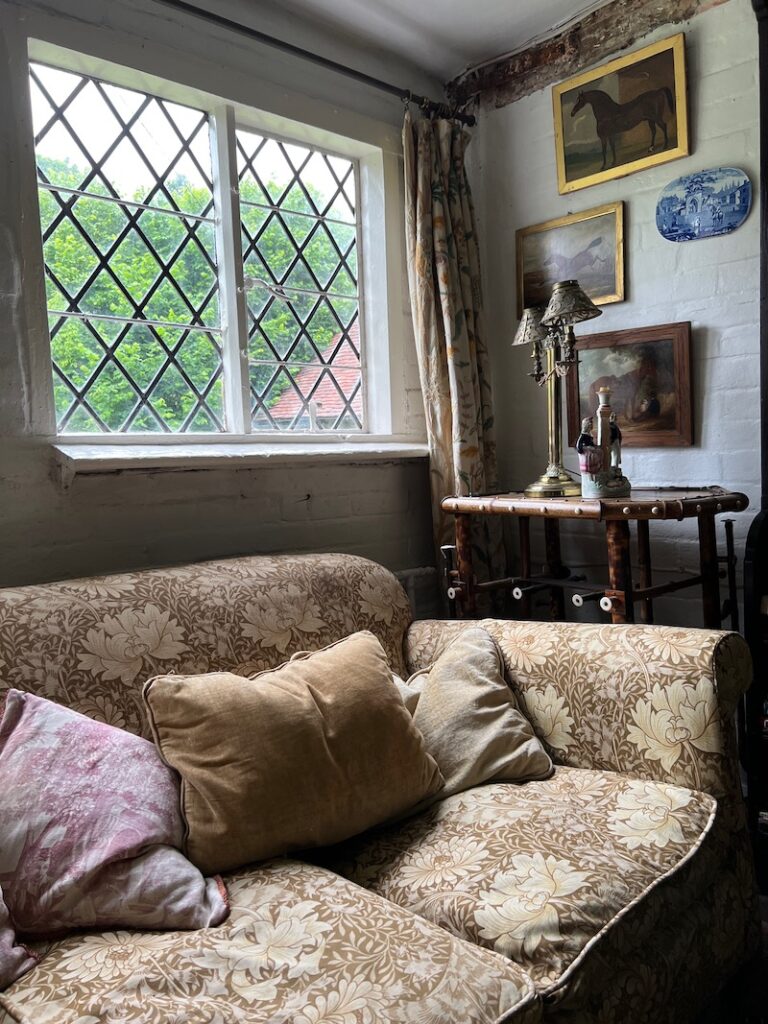
‘Everything is such a long time ago, you just can’t imagine what it was like. Oh, we had such adventures! Once I was so ashamed, one night we’d been out – I was probably pursuing a sale – and came back a bit late and I saw Emily’s footsteps in the snow! She was carrying her little brother, she was only 4, and they’d gone off to see Miriam our neighbour.’
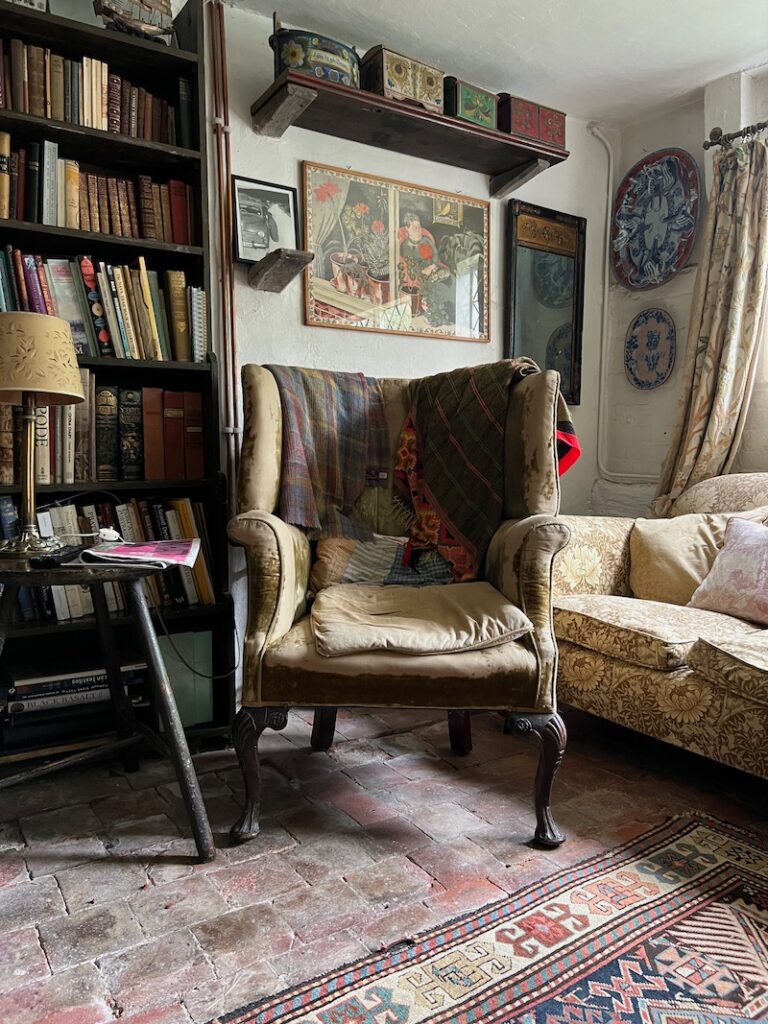
‘When Emily was 2, I took her to a furniture sale at Chichester and she disappeared. I rushed and told a policeman – and he found her on a bus!’
‘I remember getting on, it was a bit like a dare’ – Emily Andersen
‘Now you’d get the most terrible choking off! None of that in those days – he was so sweet, the policeman.’
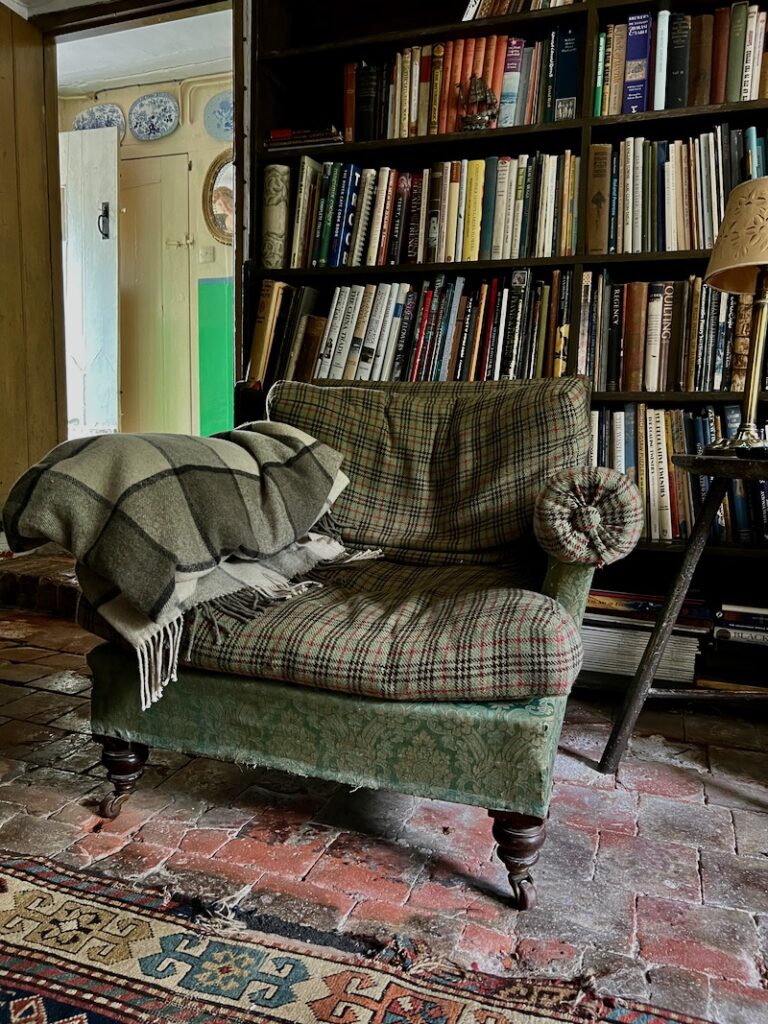
Emily Andersen – ‘We could do what we wanted in our bedrooms. In London, you took us to David Oliver and we could choose our wallpaper. I do remember moving furniture around, often. And we had old toys, lead soldiers. A rocking chair painted green that you could go from one end of the house to the other on –‘
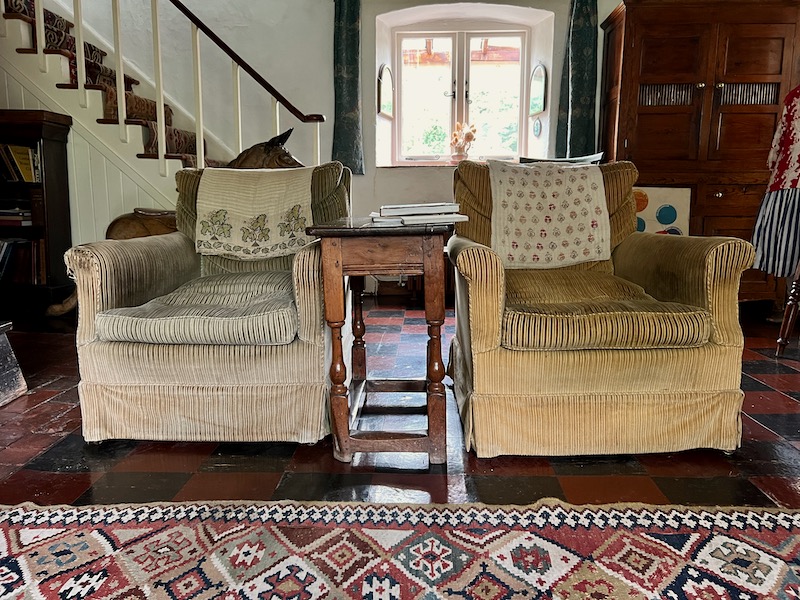
Emily Andersen – ‘You were working all the time. You went out on a Saturday – we’d go with you sometimes – and you wouldn’t get back until about 3 or 4. I quite enjoyed it. There was one very frightening dealer on the road to Petworth, Mrs Bate. But you found amazing things there – ‘
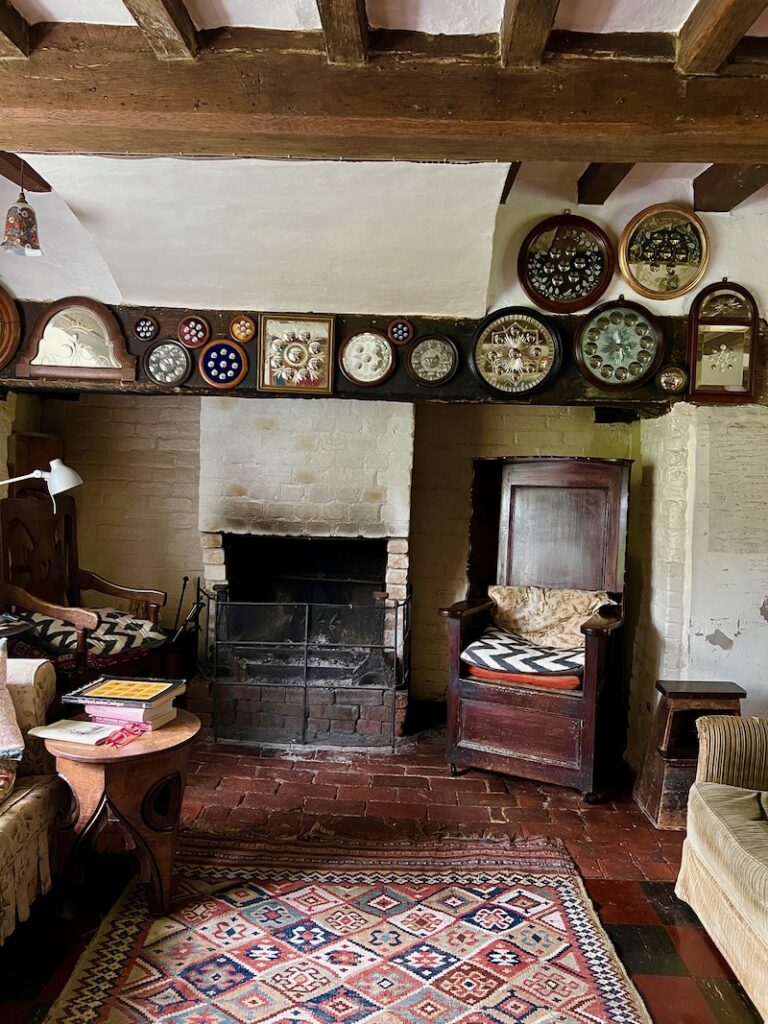
‘You have to have heating on here in winter. We used to have a tiny little anthracite boiler in this chimney place. We rang the boiler man when it broke down and he said, Mrs Andersen are you going to die cold in your bed in the winter. with money in the bank!? He came down and put in central heating for us.’
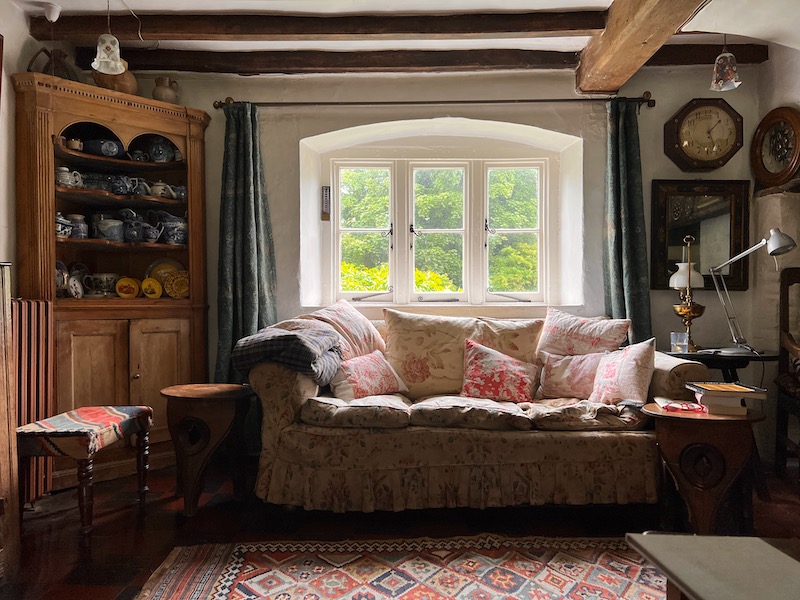
‘I got the shop [@lacquerchest] in ’61. Viv was much better at it than I. Viv would go up to the shop for one or two days. I’d go on the other days. Viv used to come down here from London on a moped, we came by car. I think he would have liked to live here. ’
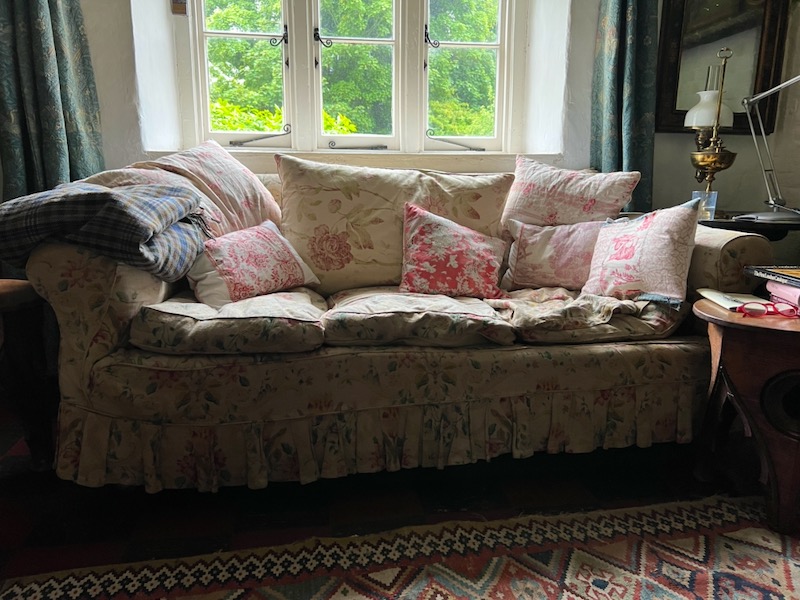
‘It’s a hugely friendly business, not like any other, dealers all know each other.’
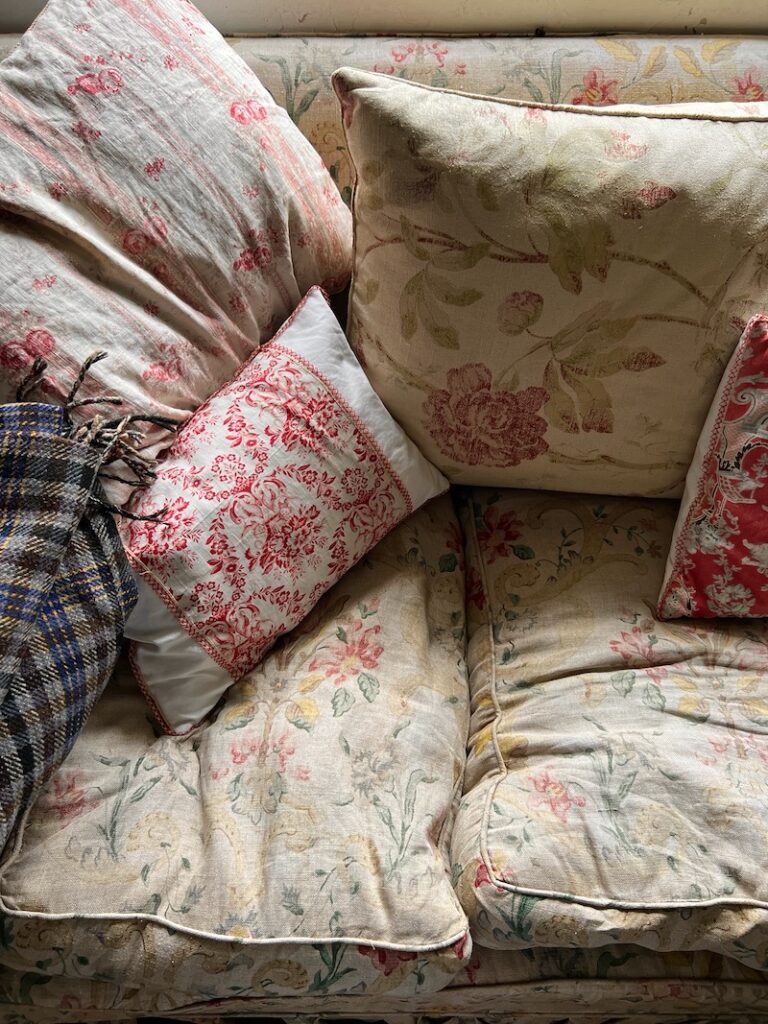
lovely sofa found in a house clearance
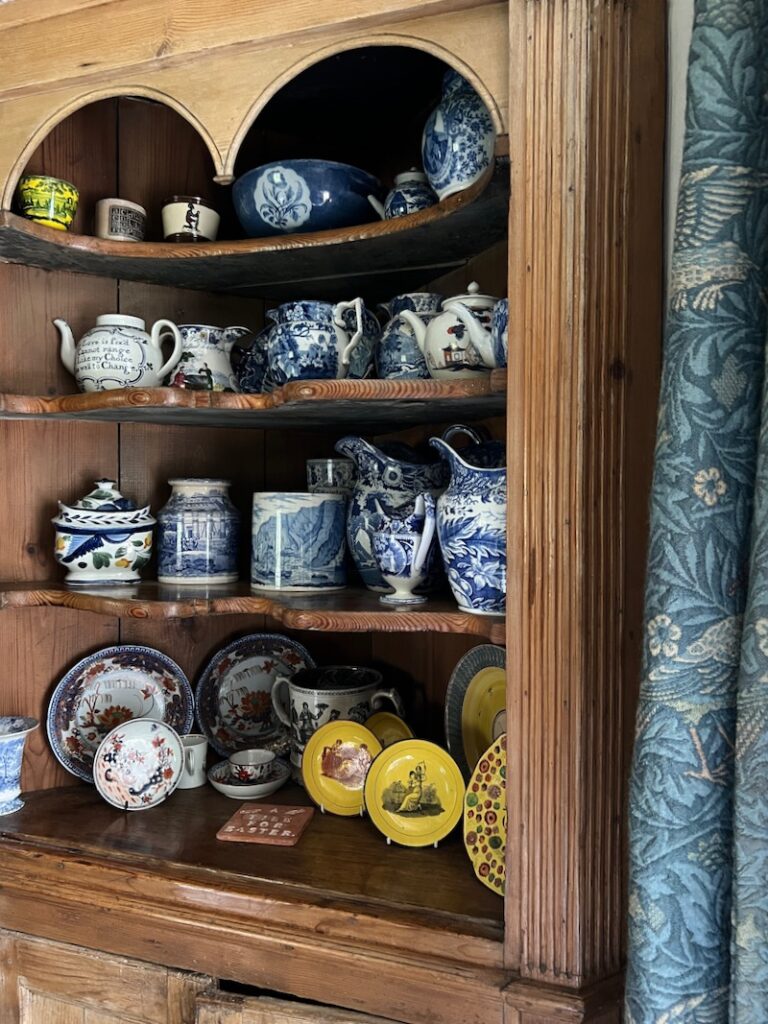
corner cupboard
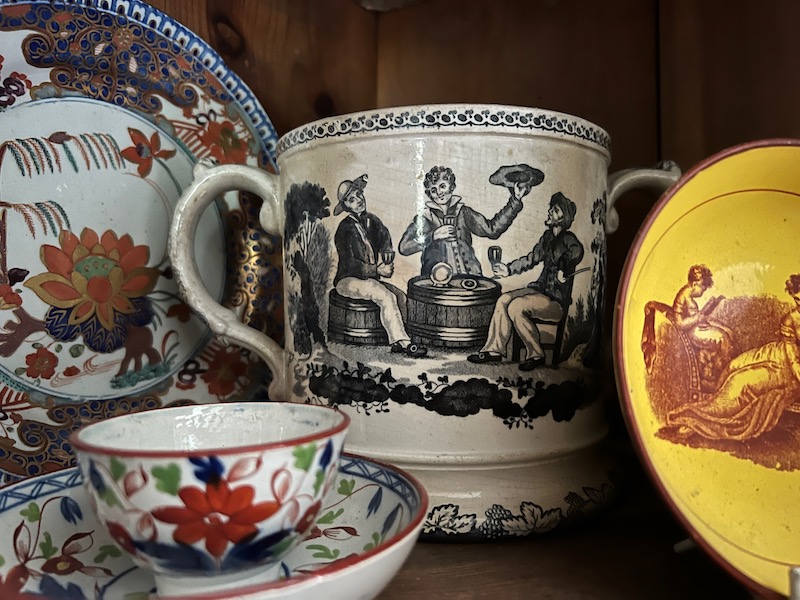

‘Everyone was modernising. When Lyons Corner House was closing we went in. Back when the Savoy hotel was modernising they called us in, and they had wonderful, wonderful old things!’
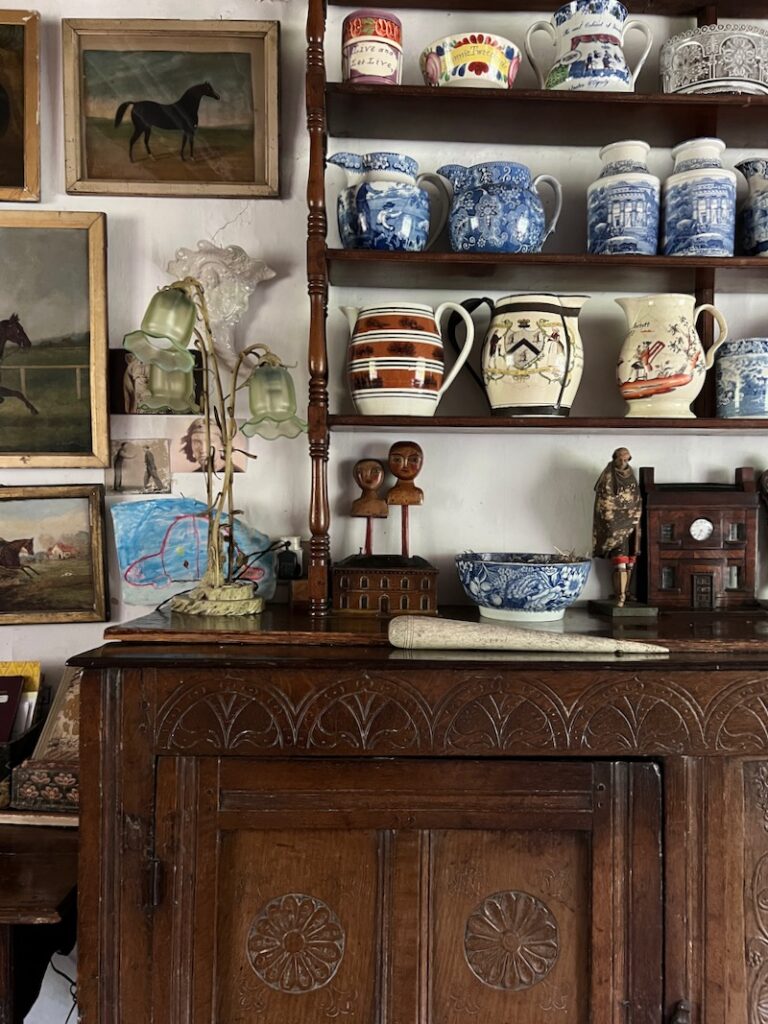
On the court cupboard, two little wooden dolls heads carved by the brilliant artist and poet David Jones during his time as a brother in the Guild of St Joseph and St Dominic with Eric Gill at Ditchling
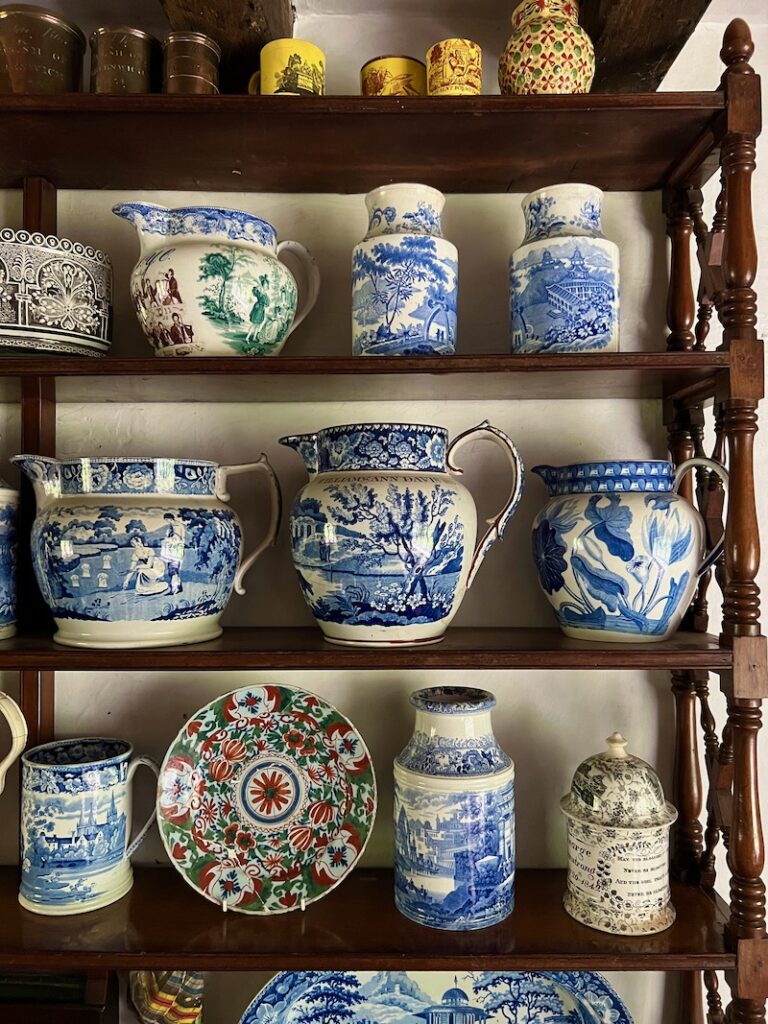
I’d known the lady at the big house here, she was an art student, they were Irish aristocracy, her husband inherited it. They were getting rid of everything – and we bought things of such good quality!
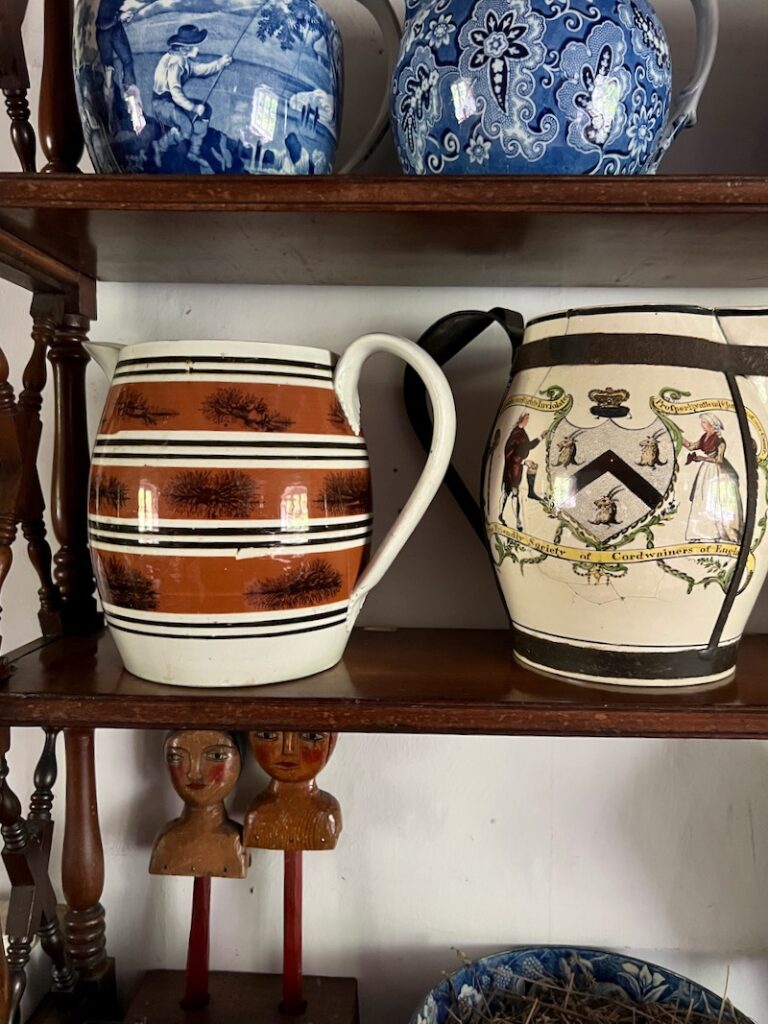
Jugs and David Jones
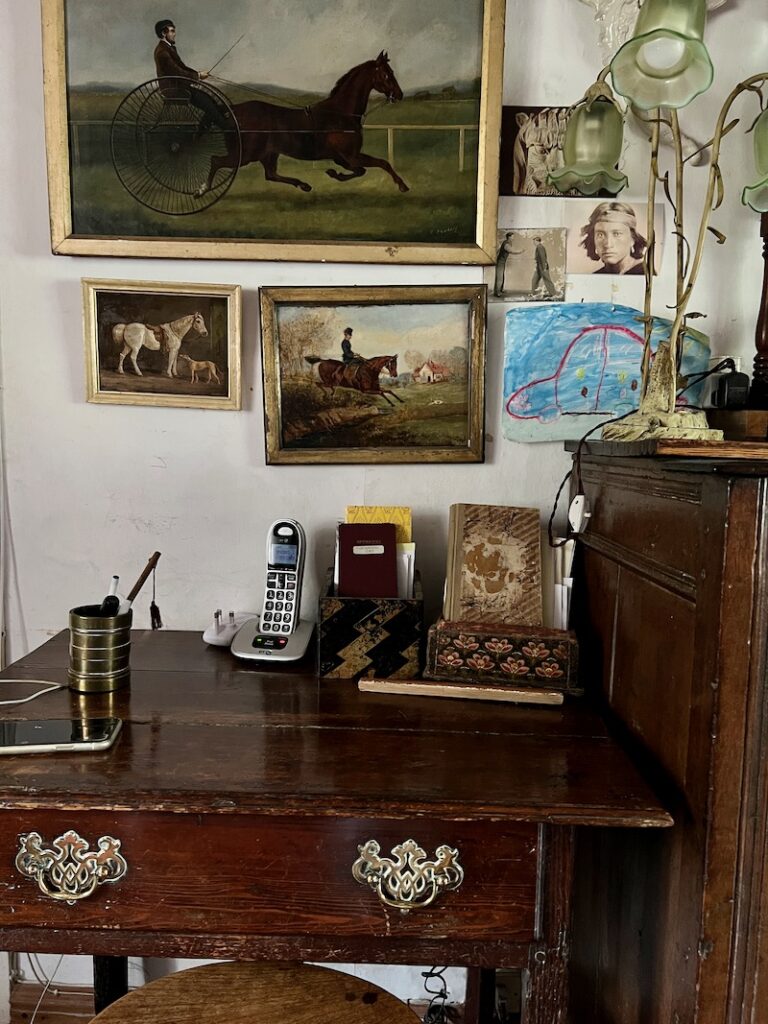
‘Two old ladies in Lewisham, spinsters – they’d lived in their house with their father since well before the war- and Viv bought masses from them, fancy dresses and all sorts of things, and the last day he went, one said, There’s some frames downstairs in the cellar, father put them down when there were bombs.’
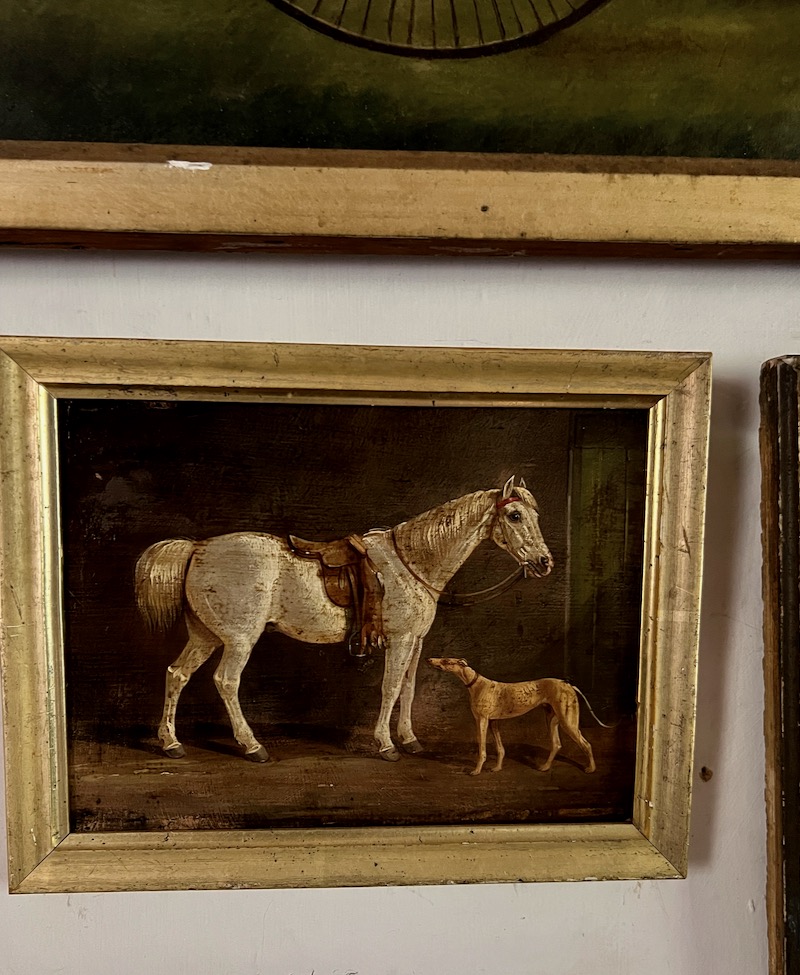
bomb survivor
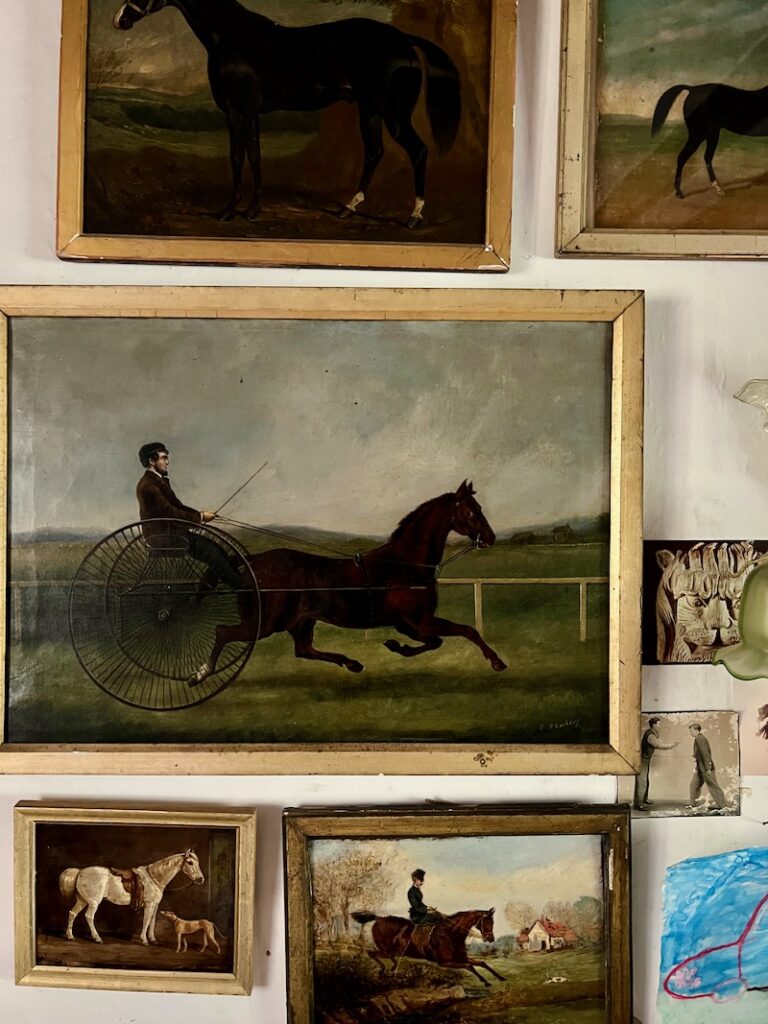
‘He brought up about 20 of these pictures completely black, covered in soot. He sold one and the others we kept.’
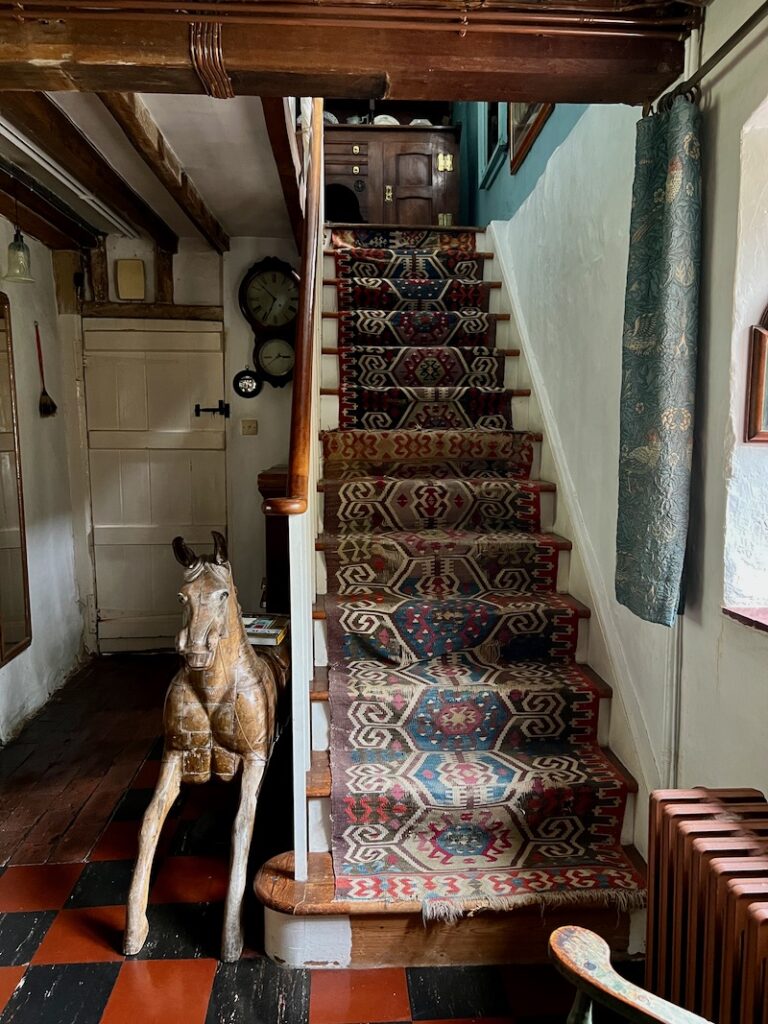
‘These are Marly tiles on the floor, I wanted this because I thought it looked like an old Dutch interior.’ The staircase is carpeted in kelims that did not sell in the shop, the fairground horse came from the groovy Troubadour cafe in the Brompton Road.
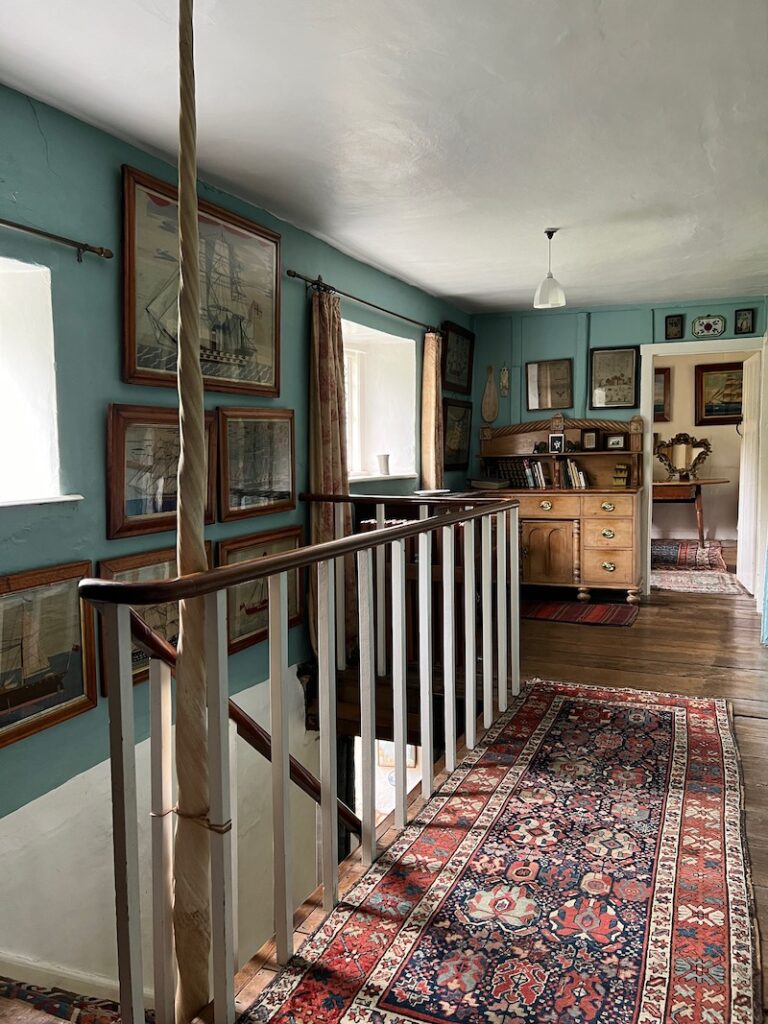
Narwhale tusk at the turn of the stair
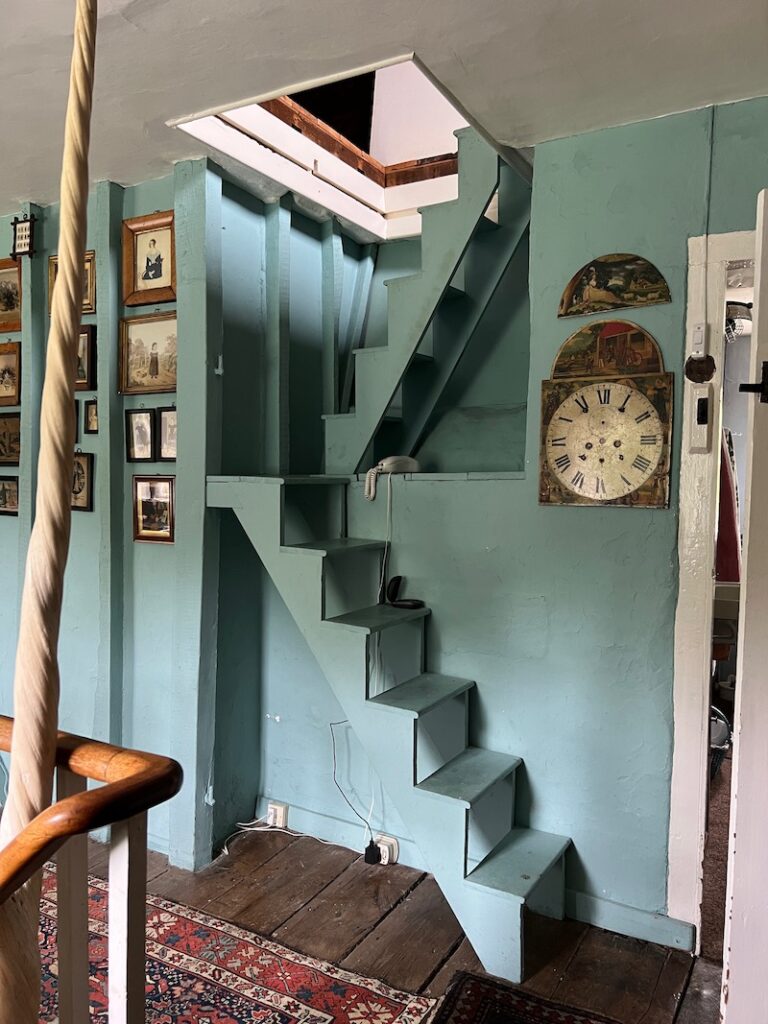
attic stairs…
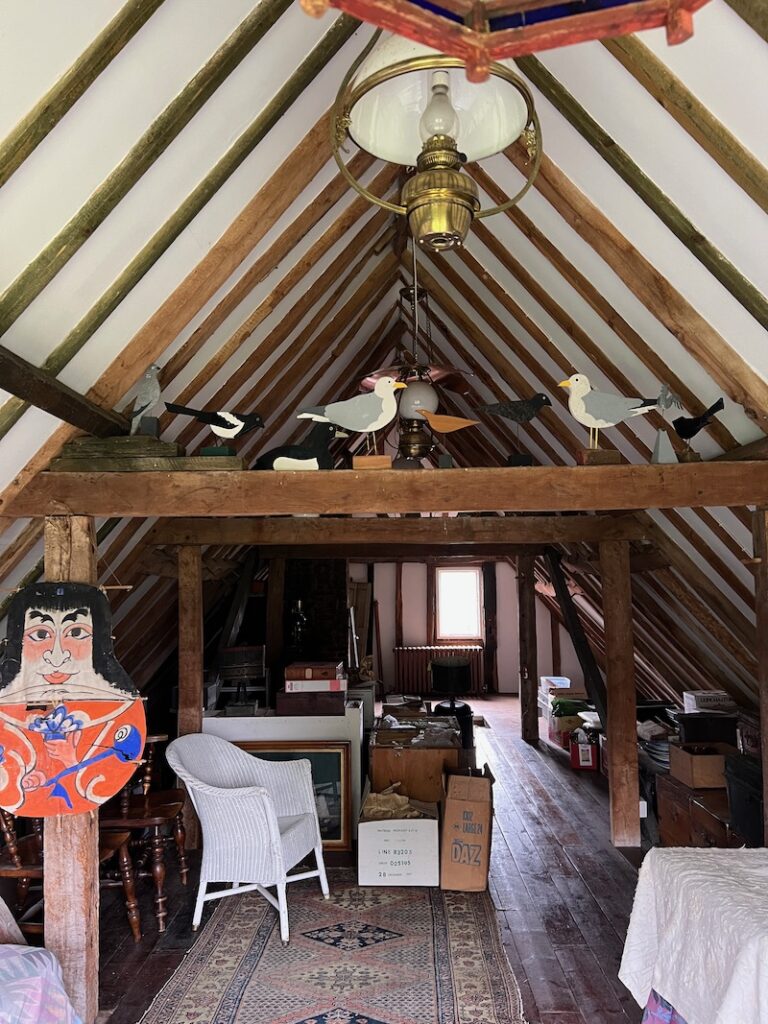
More stock waiting for the big reveal
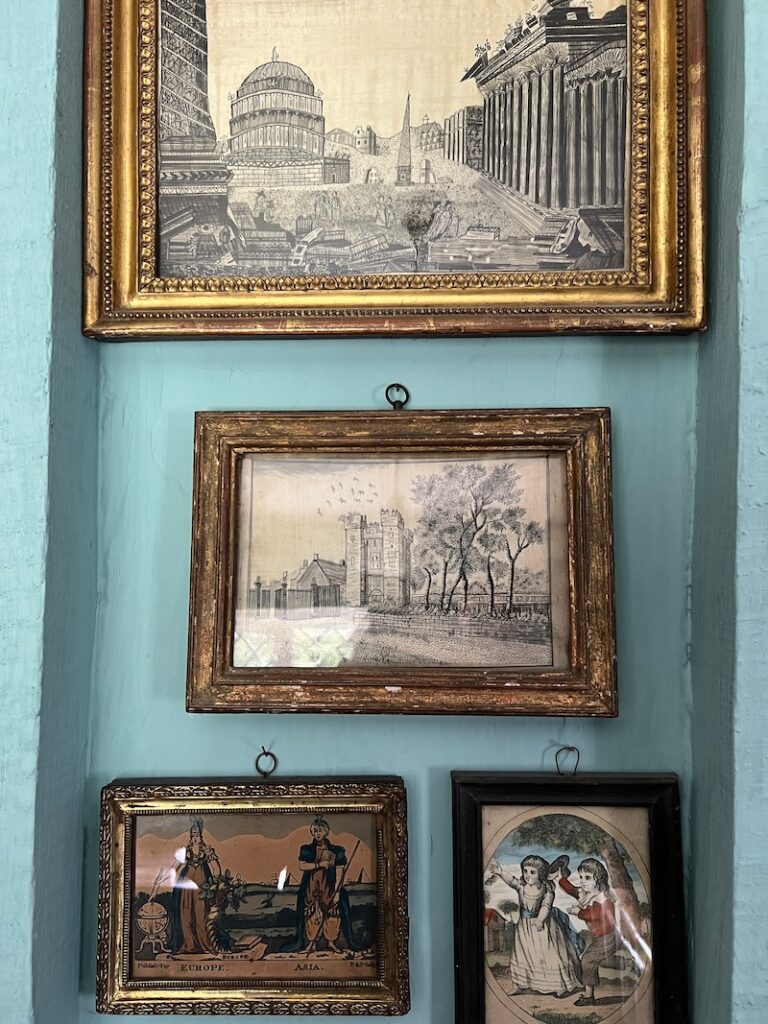
pictures on the upstairs landing
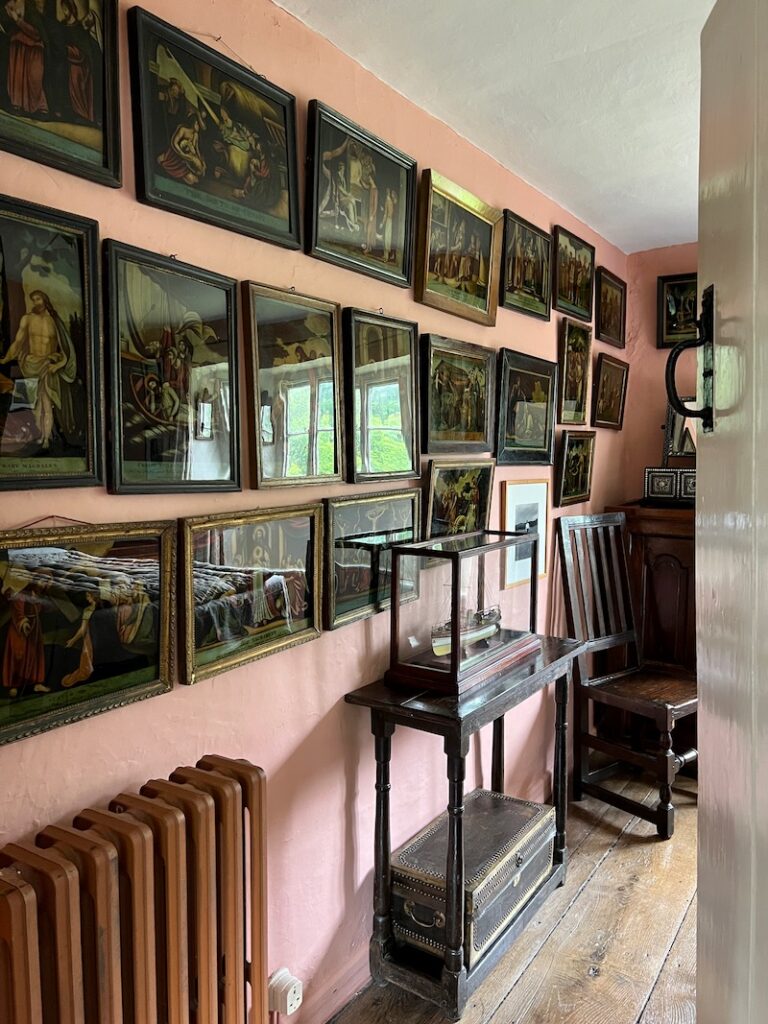
Glass paintings from c.1800 in a bedroom, religious subjects that did not sell in the shop
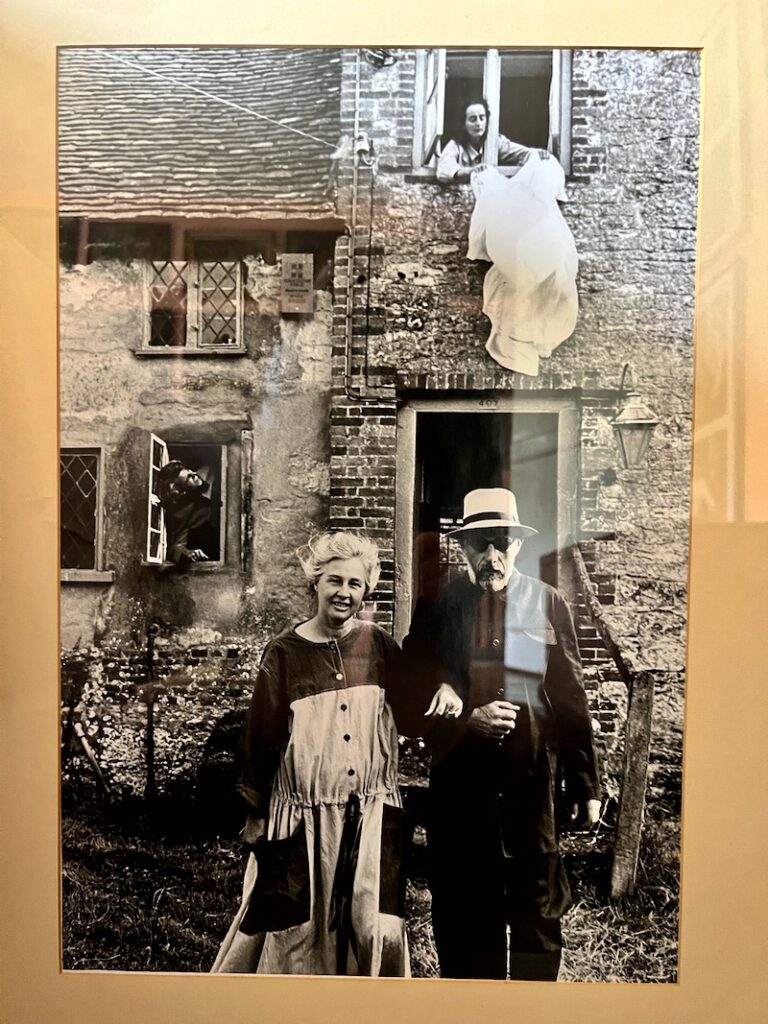
Emily Andersen – ‘This is a shot of my parents in ’87. When I first started as a photographer I did some fashion shoots. Nick Ashley [Laura Ashley’s son] and I and my brother Toby were all in the same school at Holland Park, we’re the same generation, doing the same sort of thing. Then I was photographing for the New Musical Express.’ This photo copyright Emily Andersen
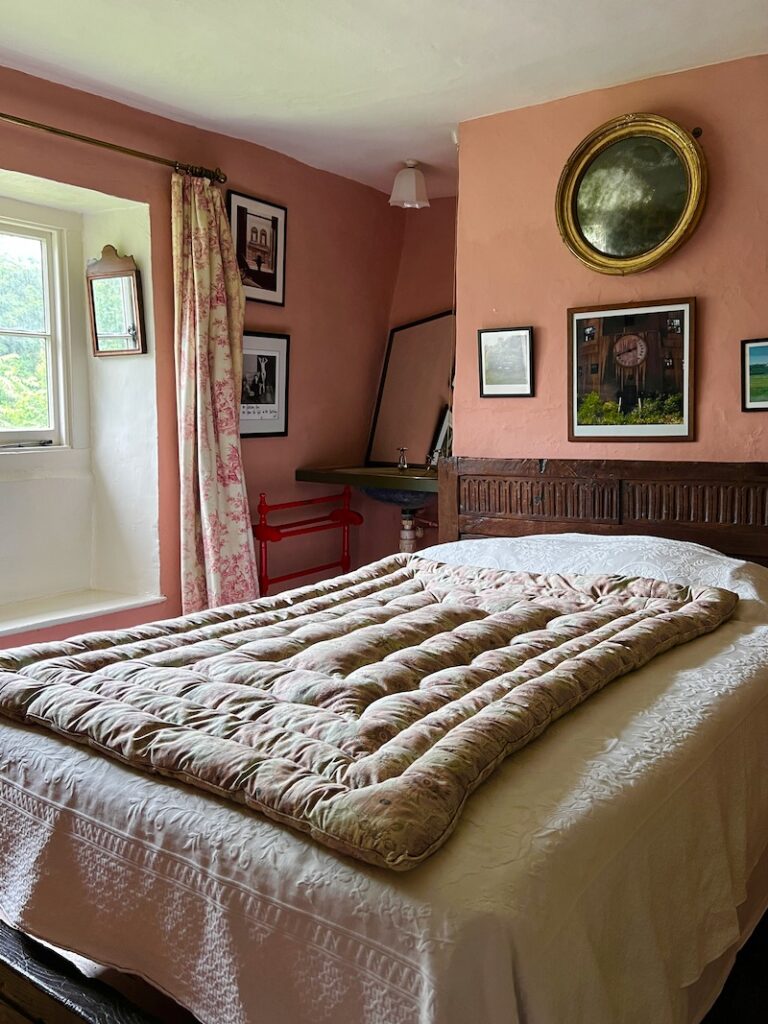
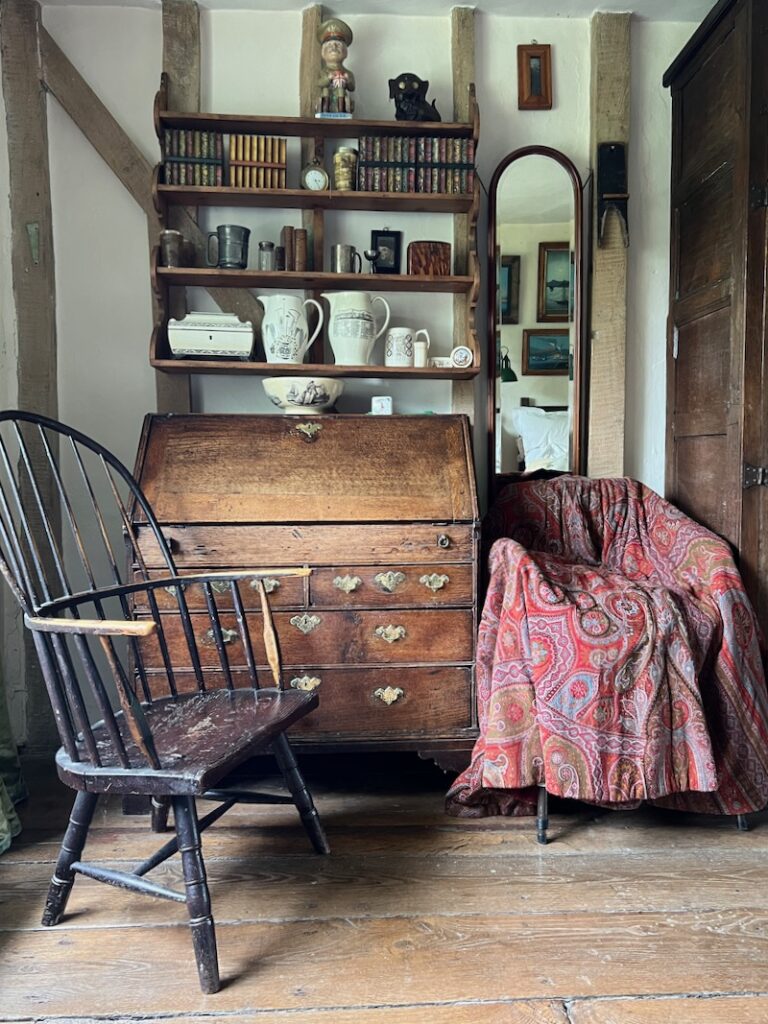
Corner of Gretchen’s bedroom
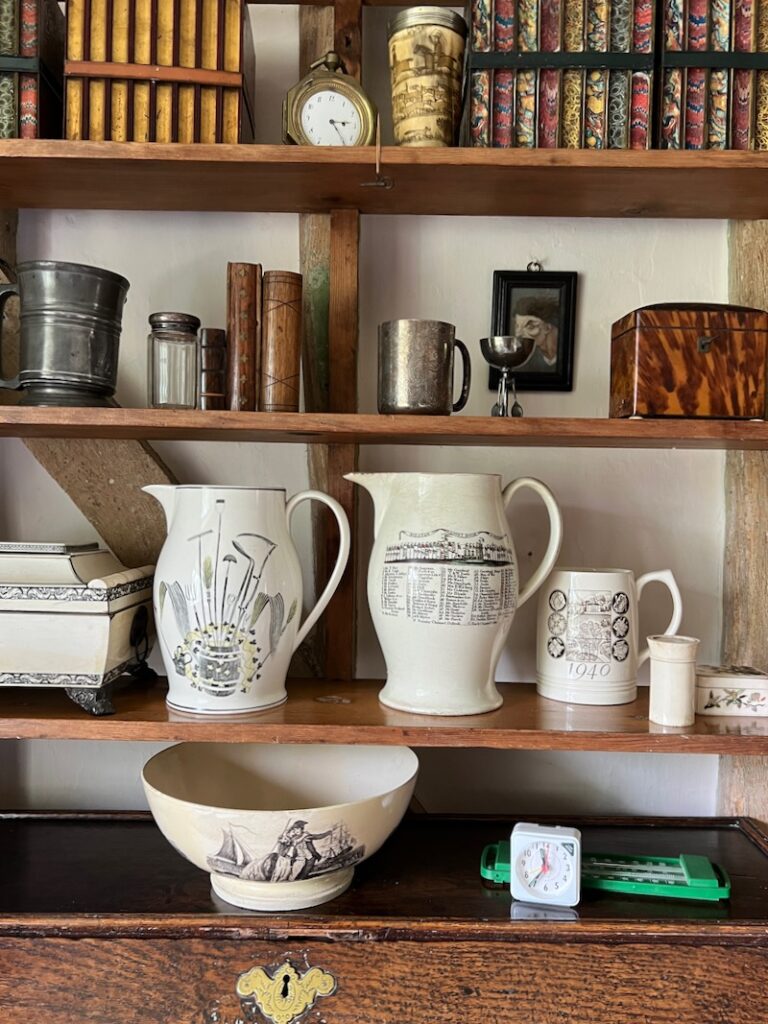
Jug by Eric Ravilious for Wedgwood
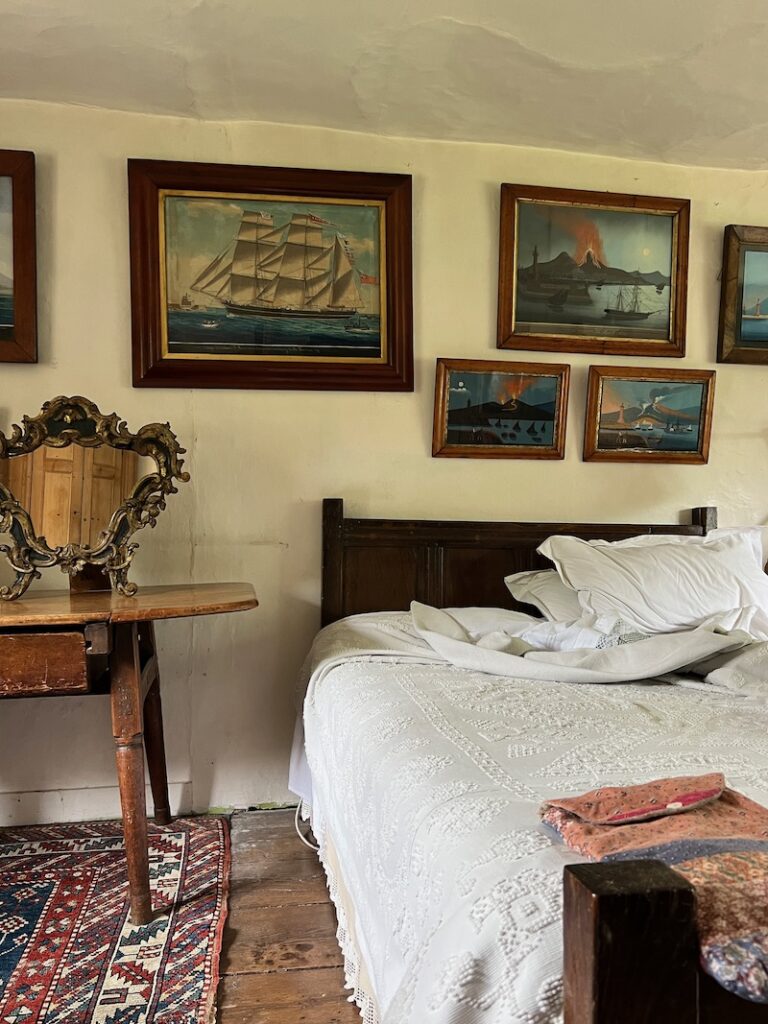
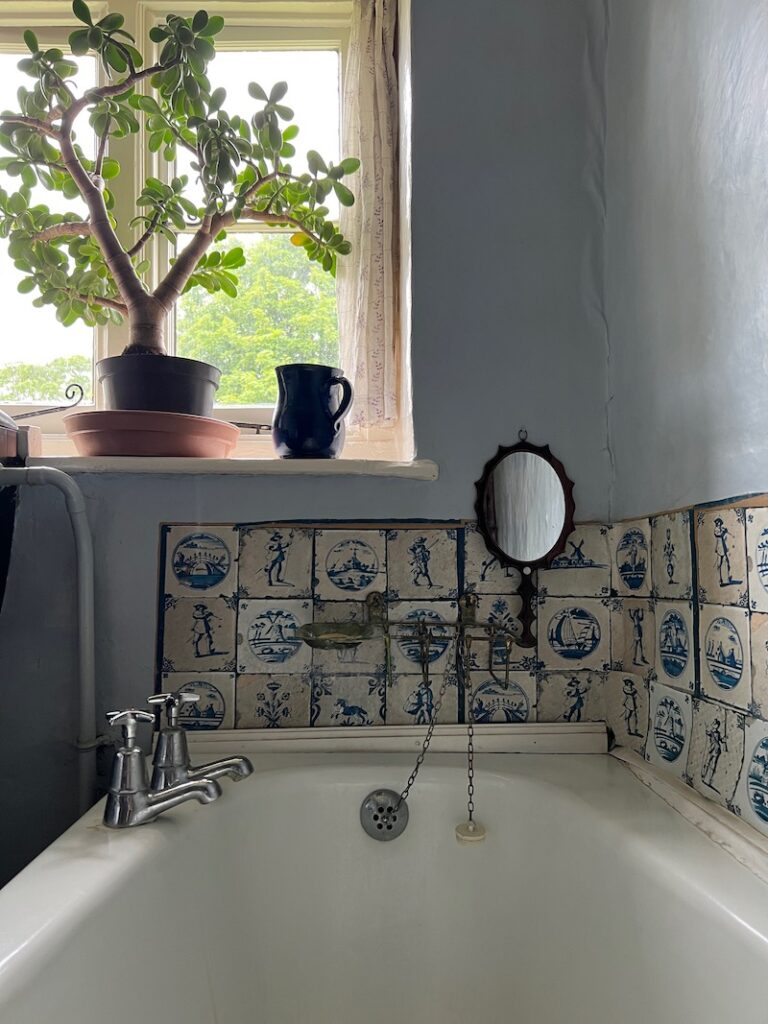
Saving the best til last – the ‘Fablon’ sticky back plastic imitating Delft tiles, and manufactured in the 1960s, the most brilliant piece of trompe l’oeil.
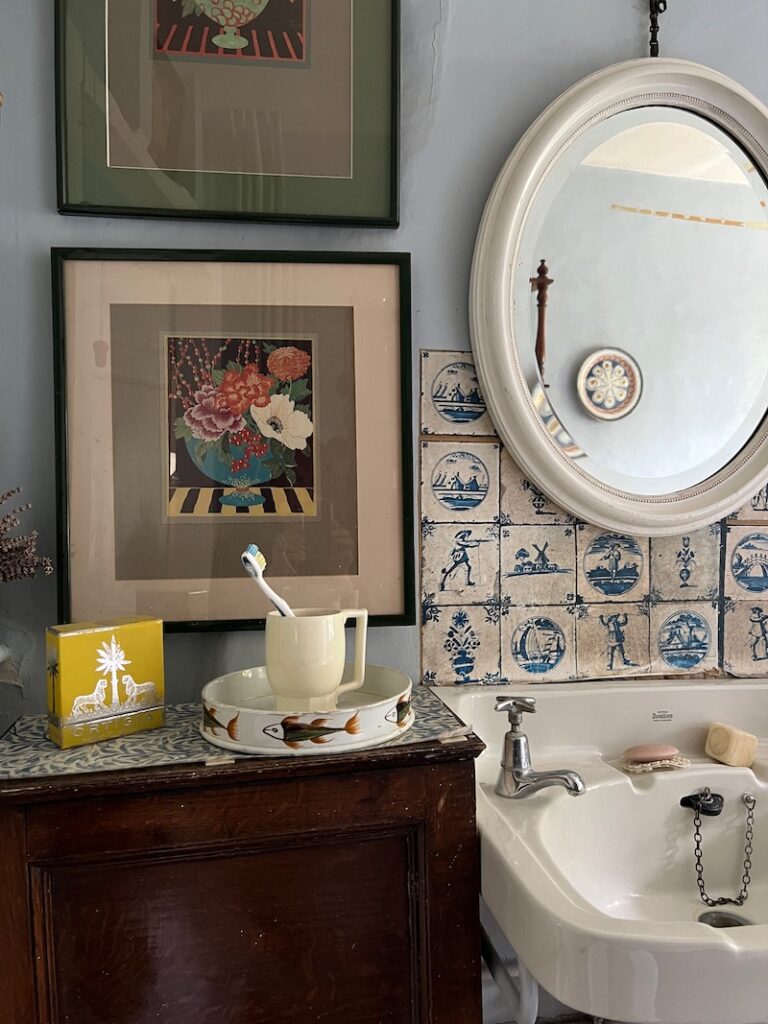
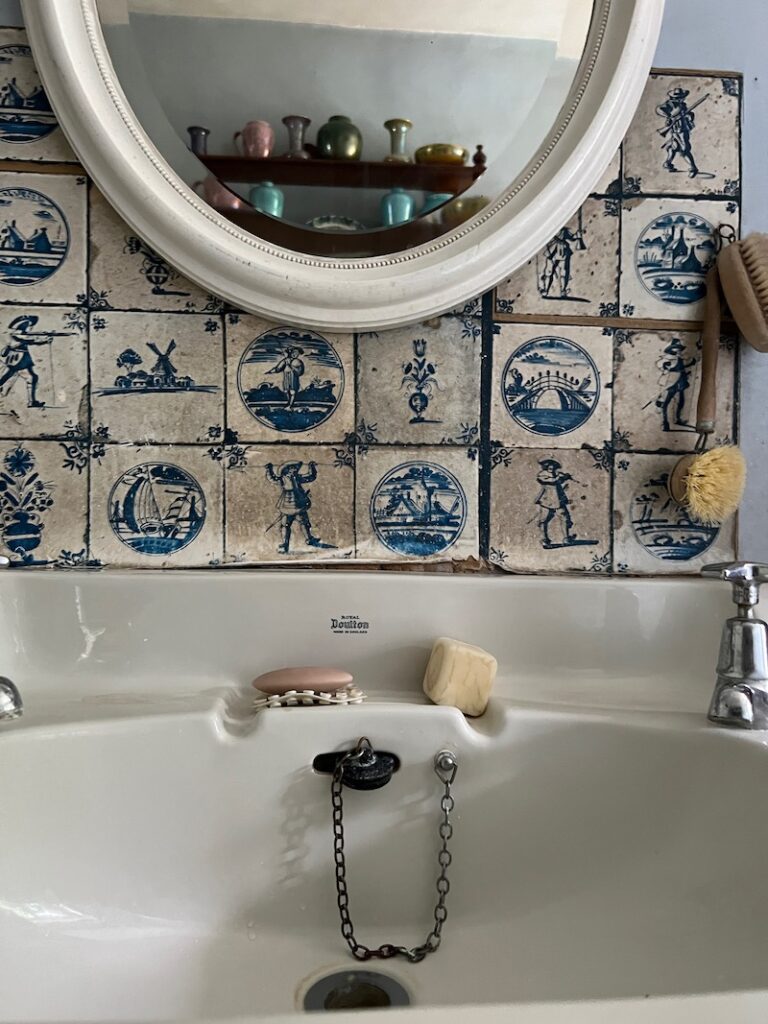
‘I just bought it, – because its so good!”
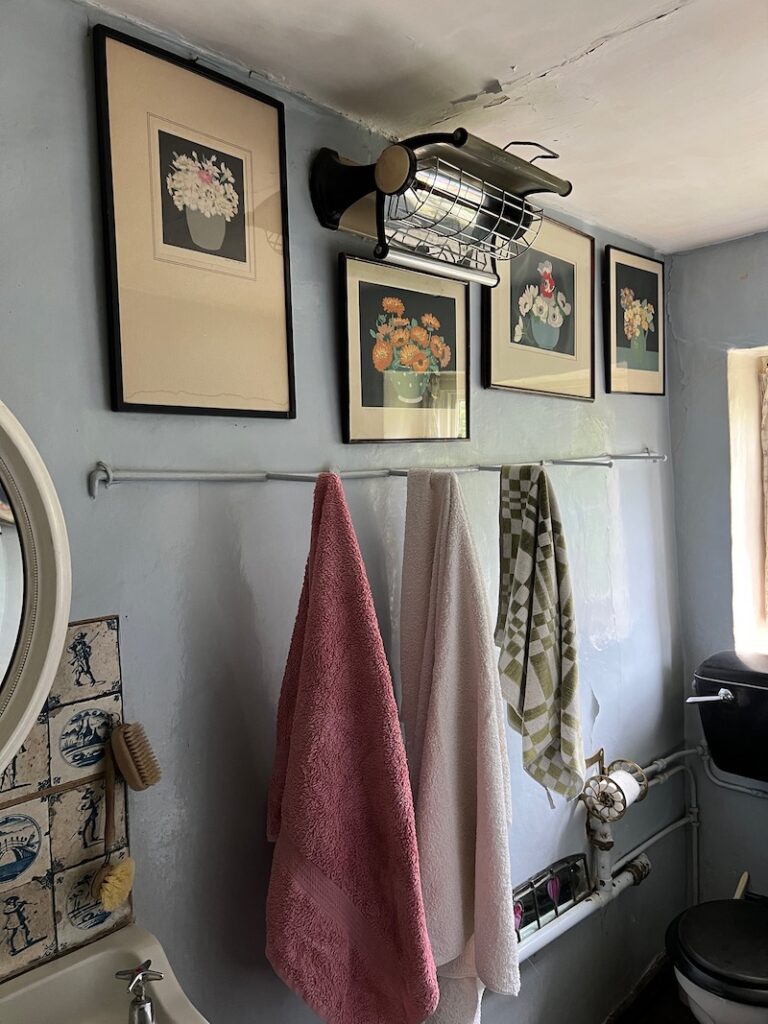
NB 2-bar electric fire suspended from the ceiling, a nifty solution
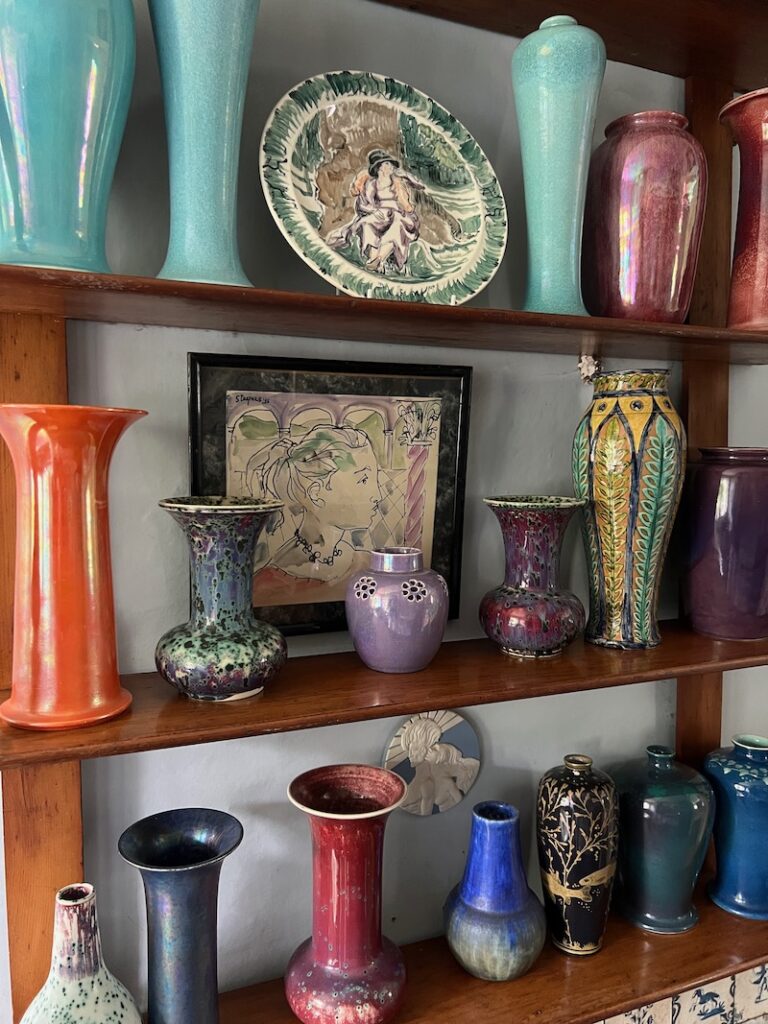
bathrooms pot stand
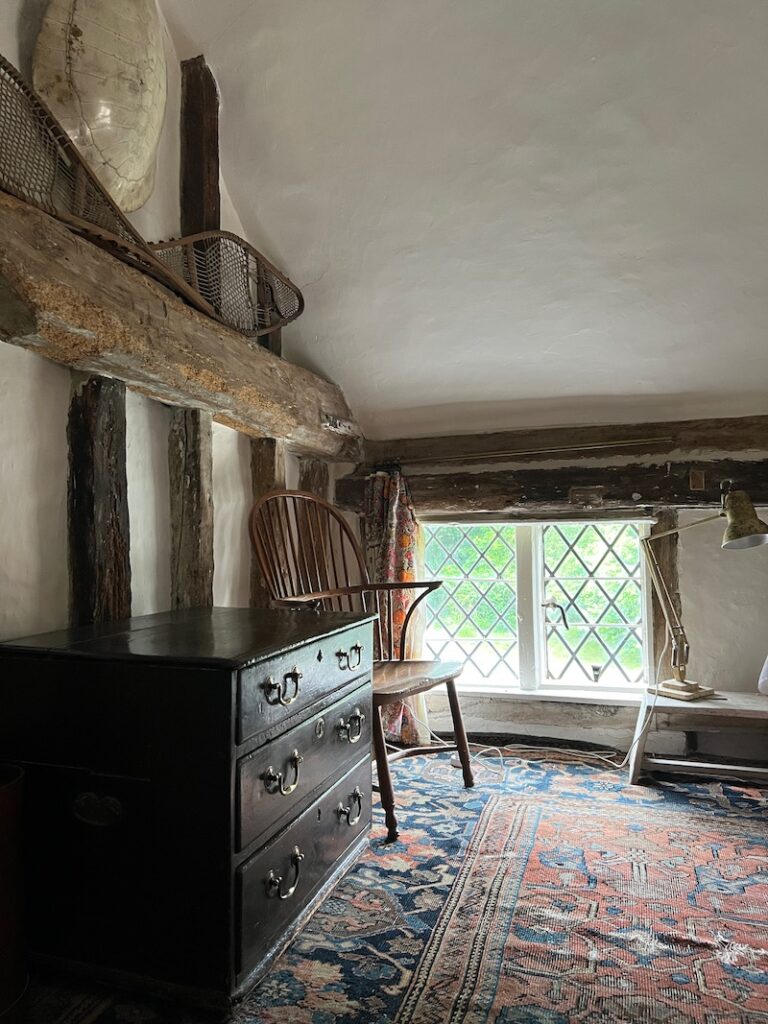
bedroom in the medieval house end
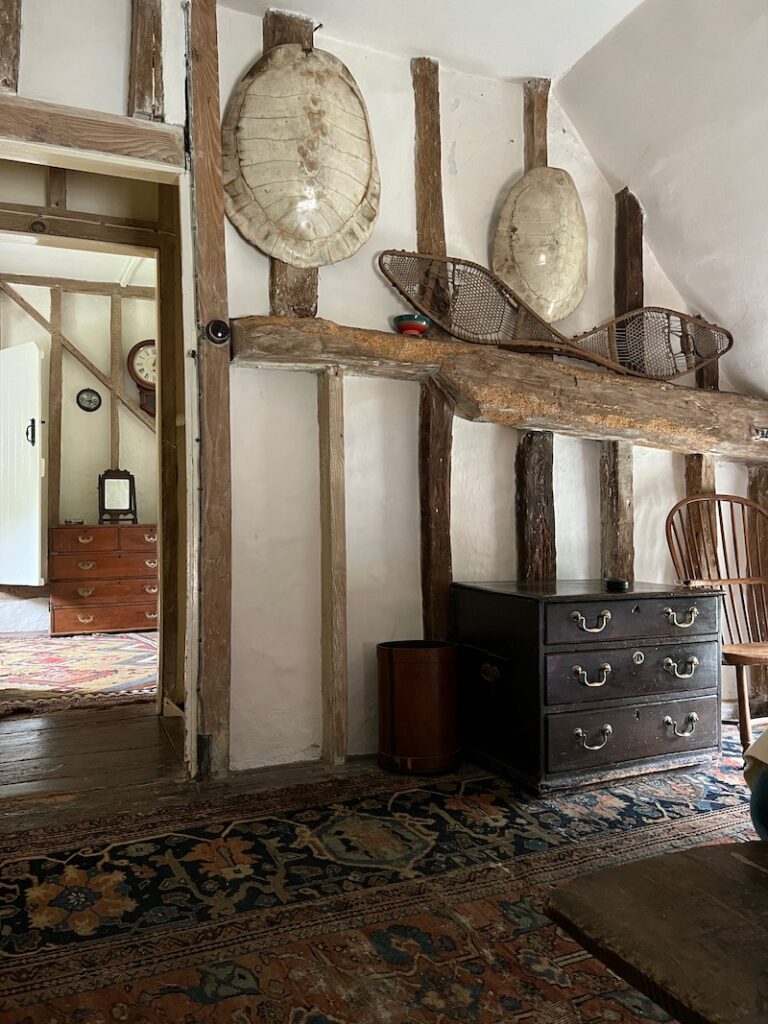
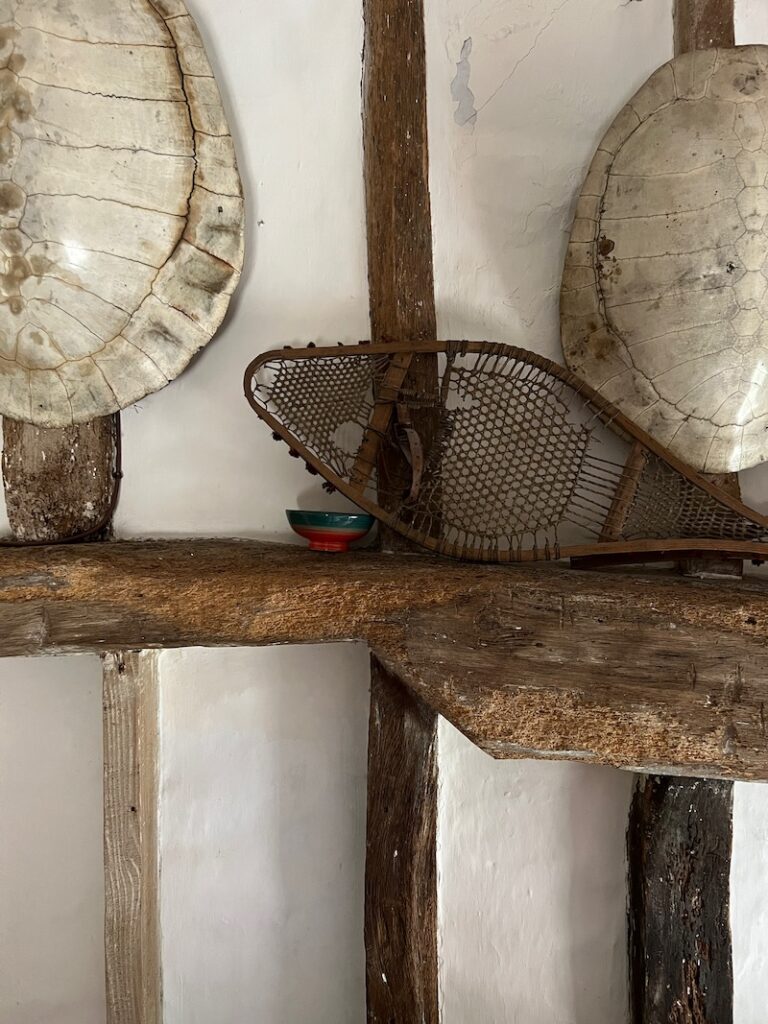
snow shoes?
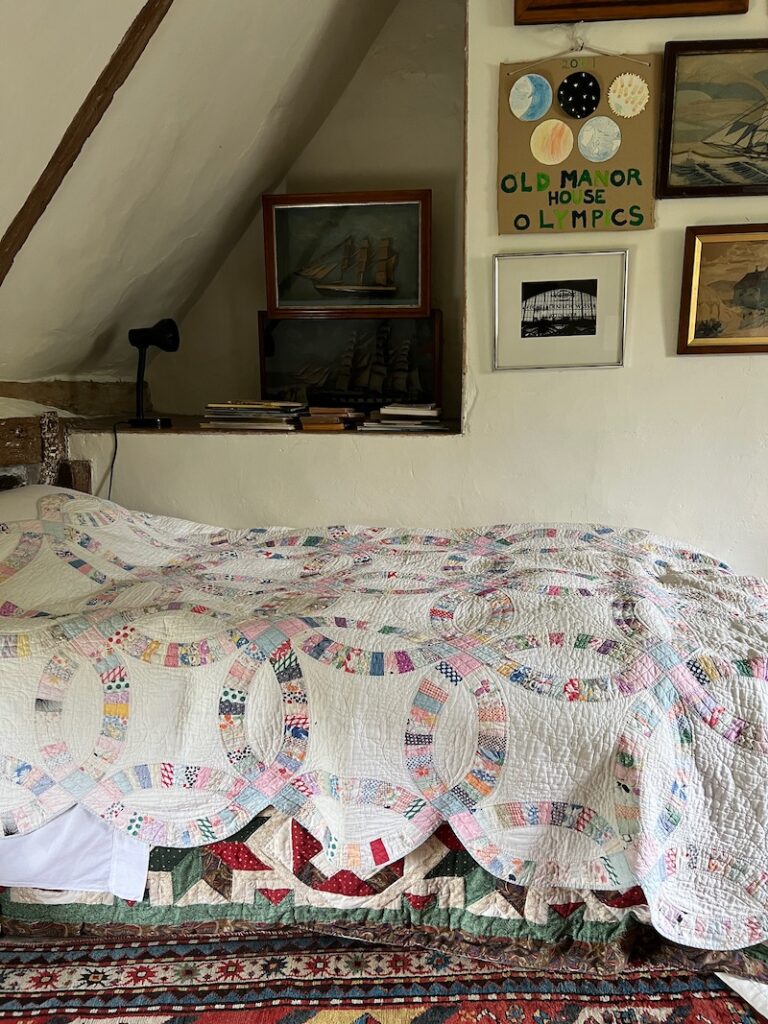
quilt
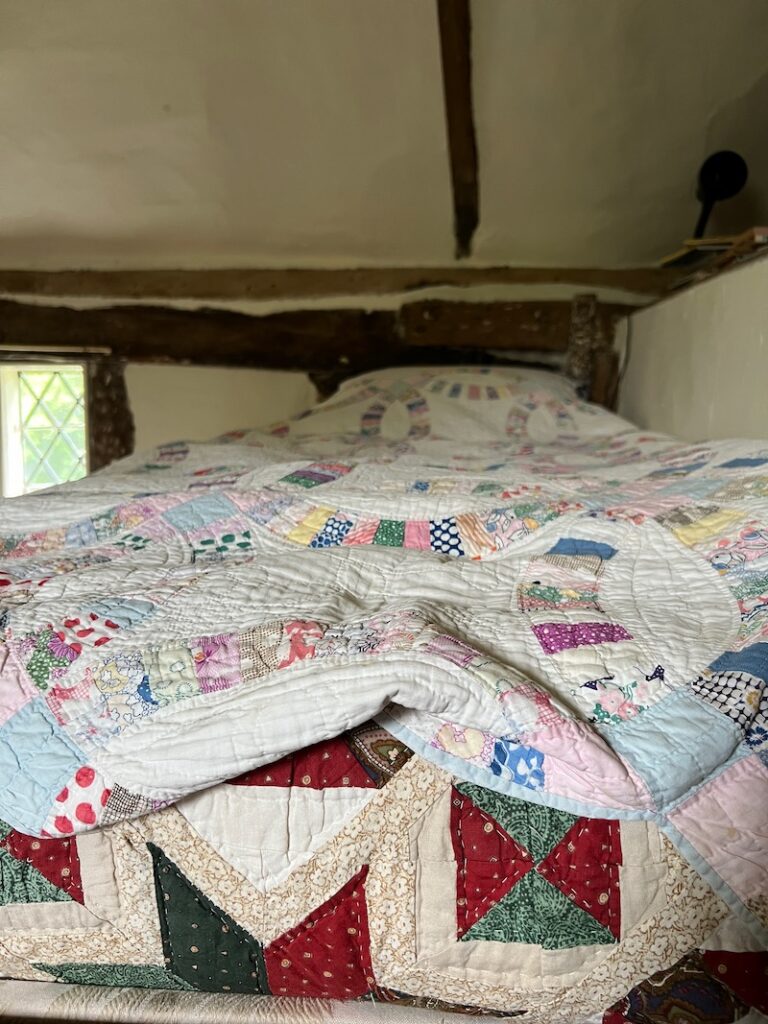
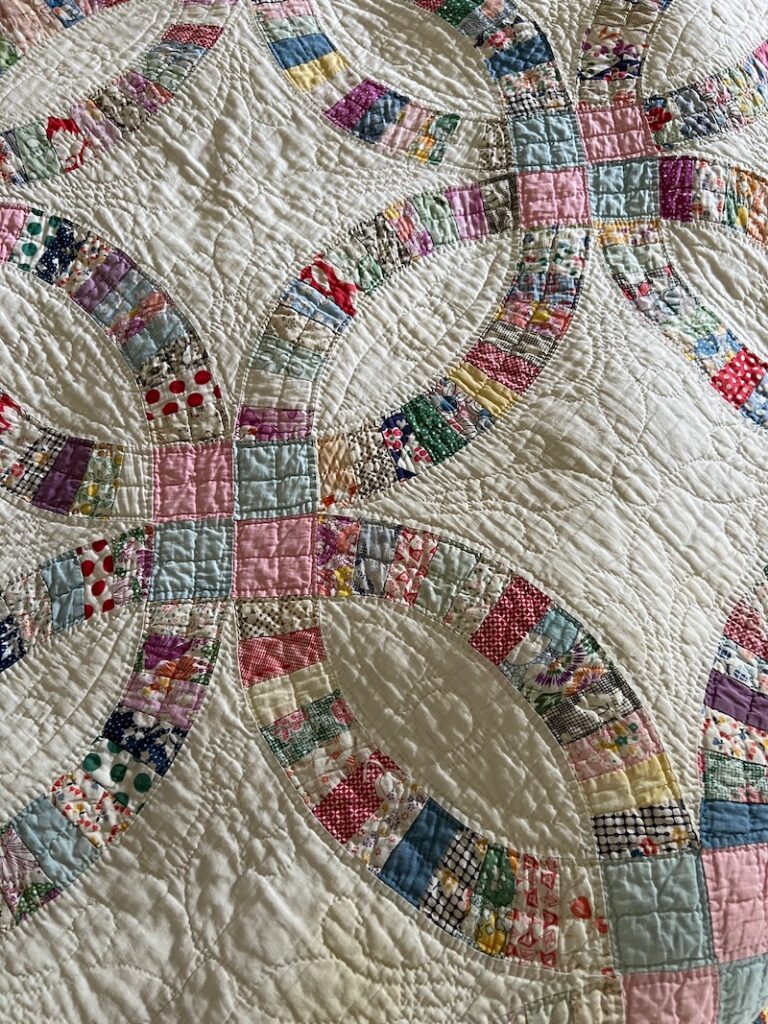
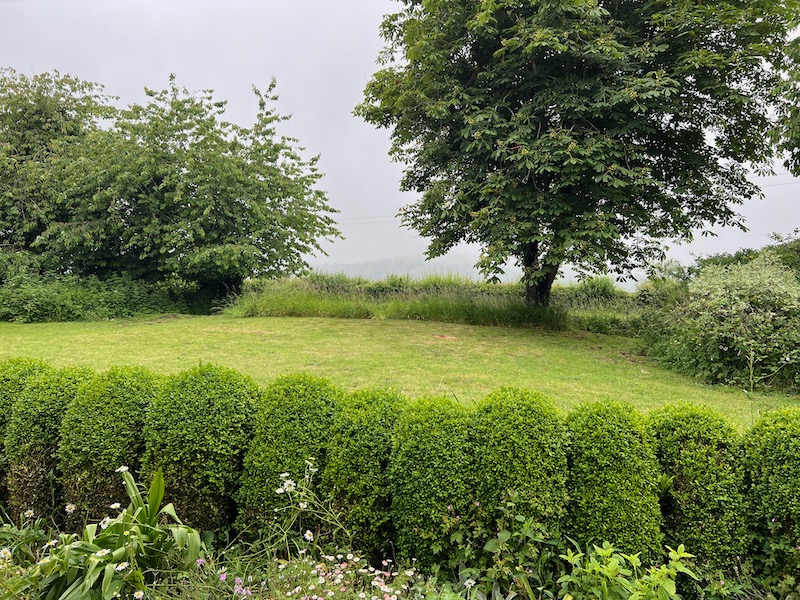
‘That’s Dunkton Hill behind, the last of the South Downs.’
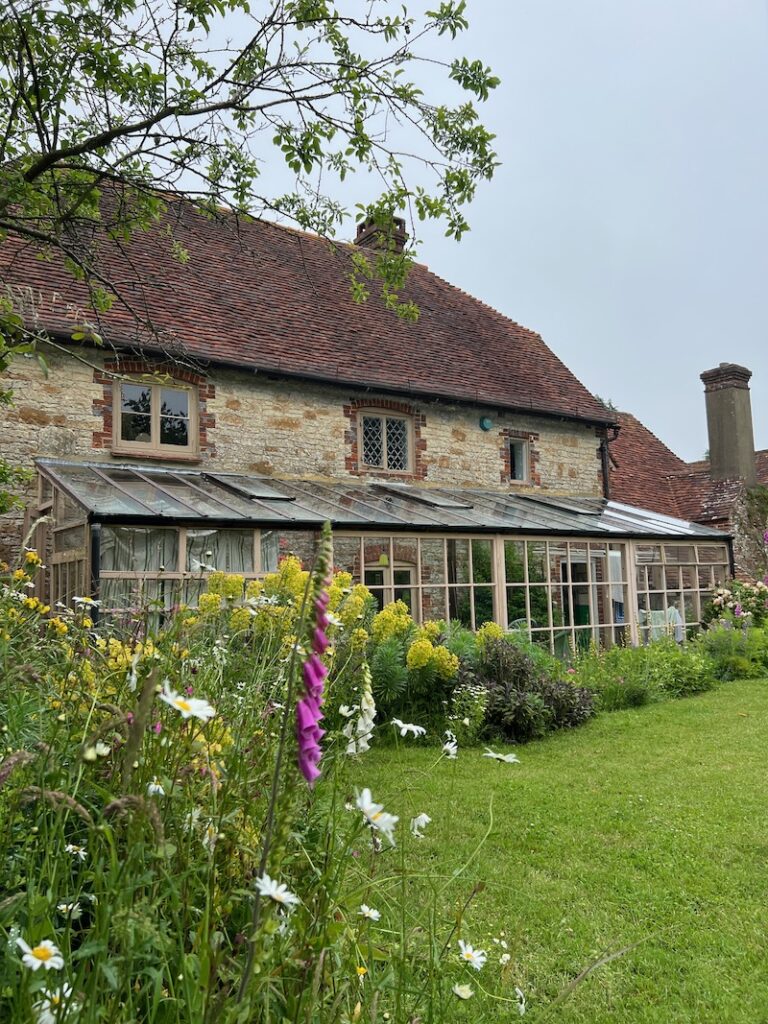
The later, C17th end of the house
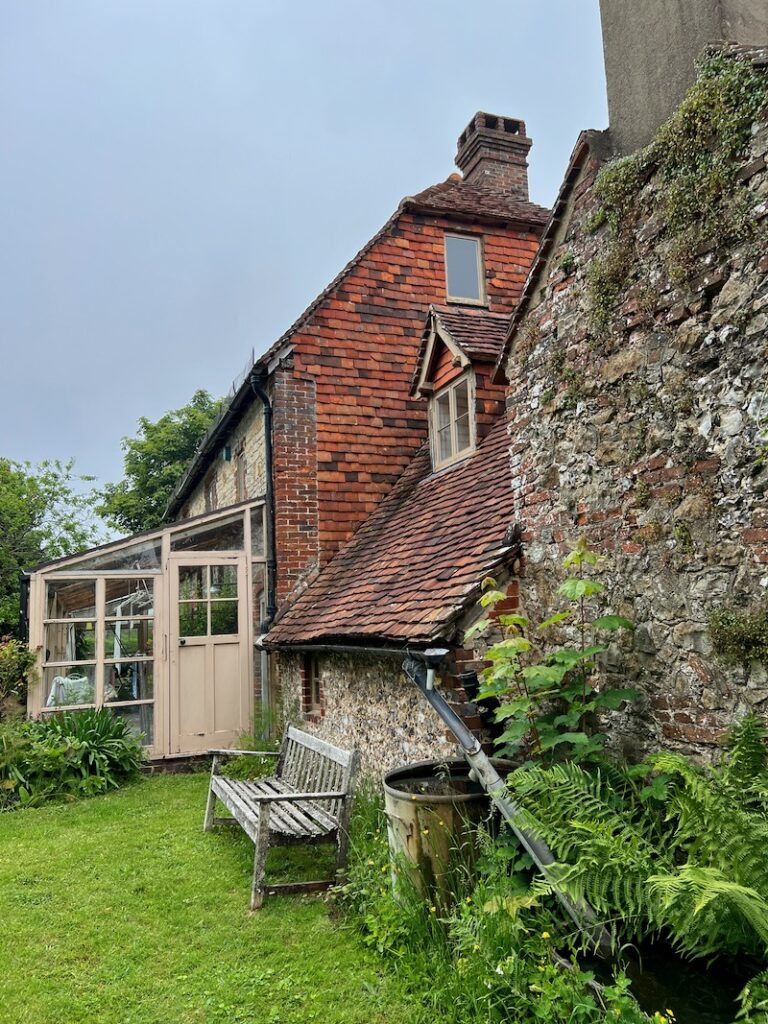
‘The wild deer from Petworth park come down and jump over the fence.’
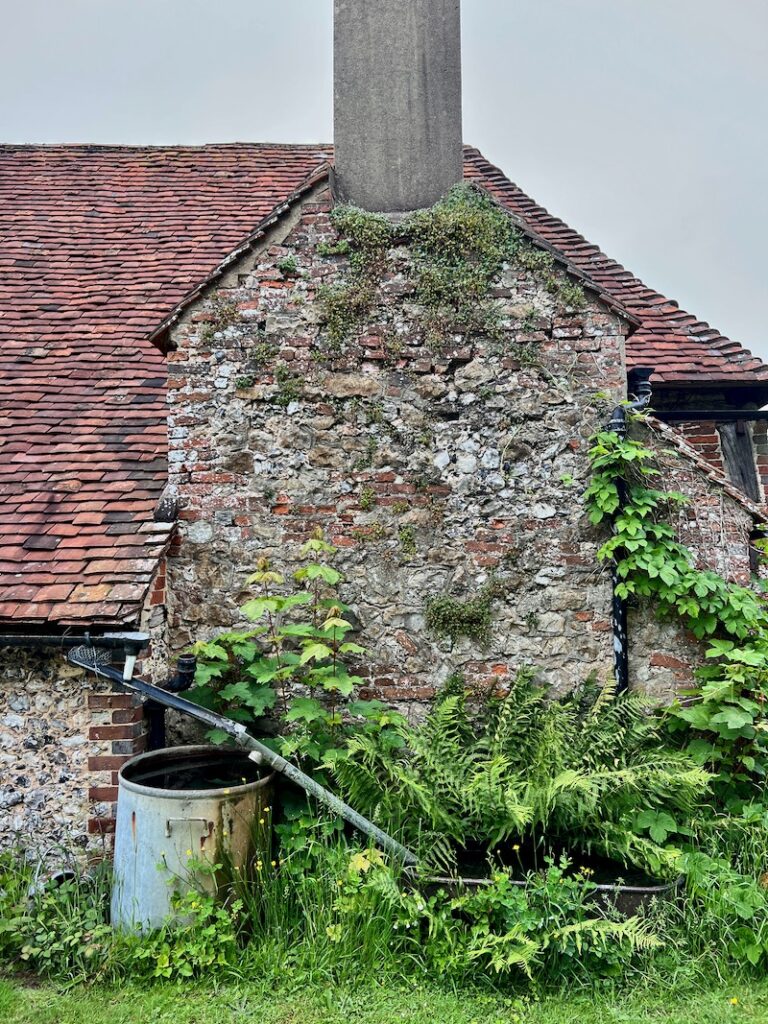
The early medieval end of the house
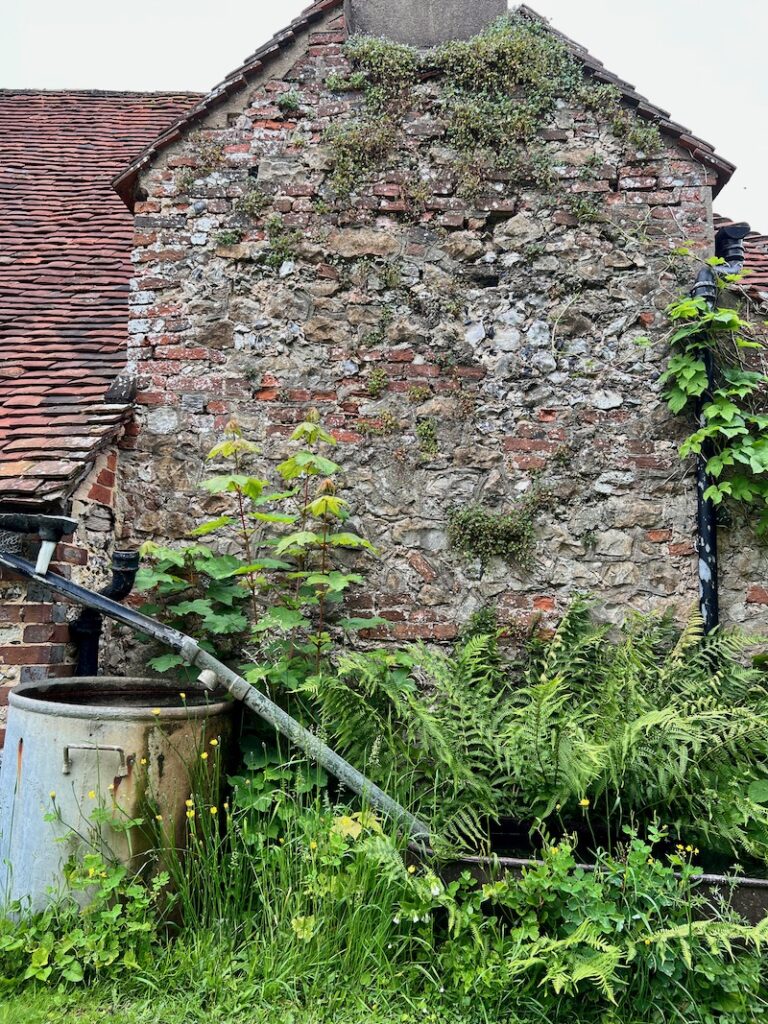
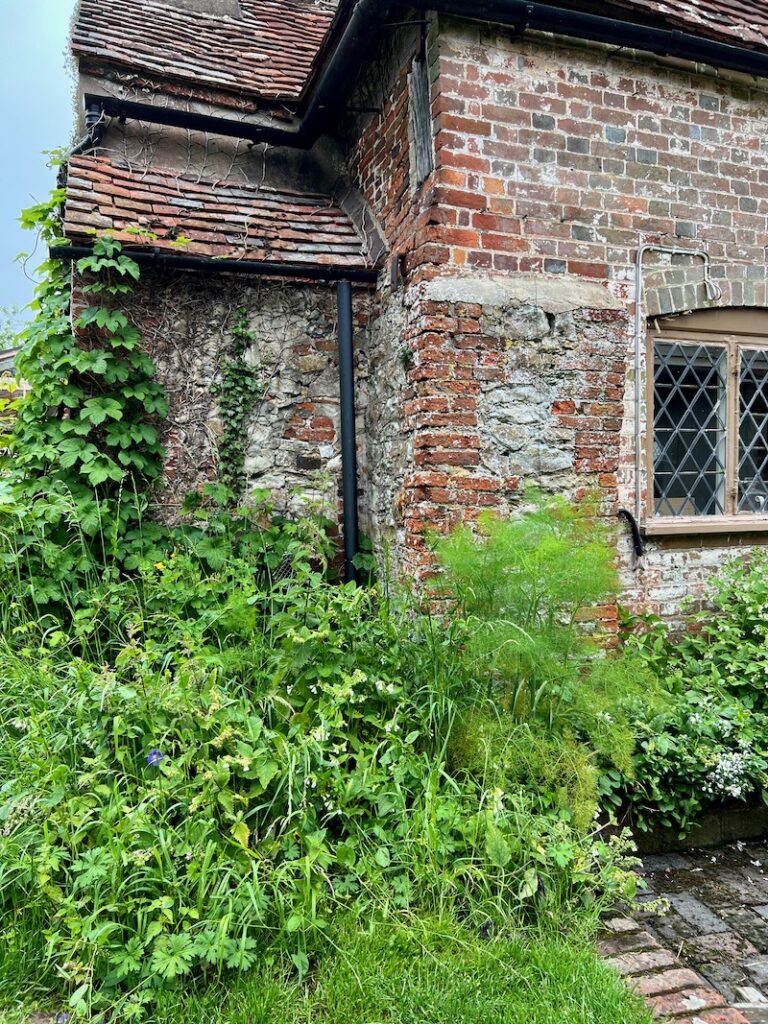
C13th…
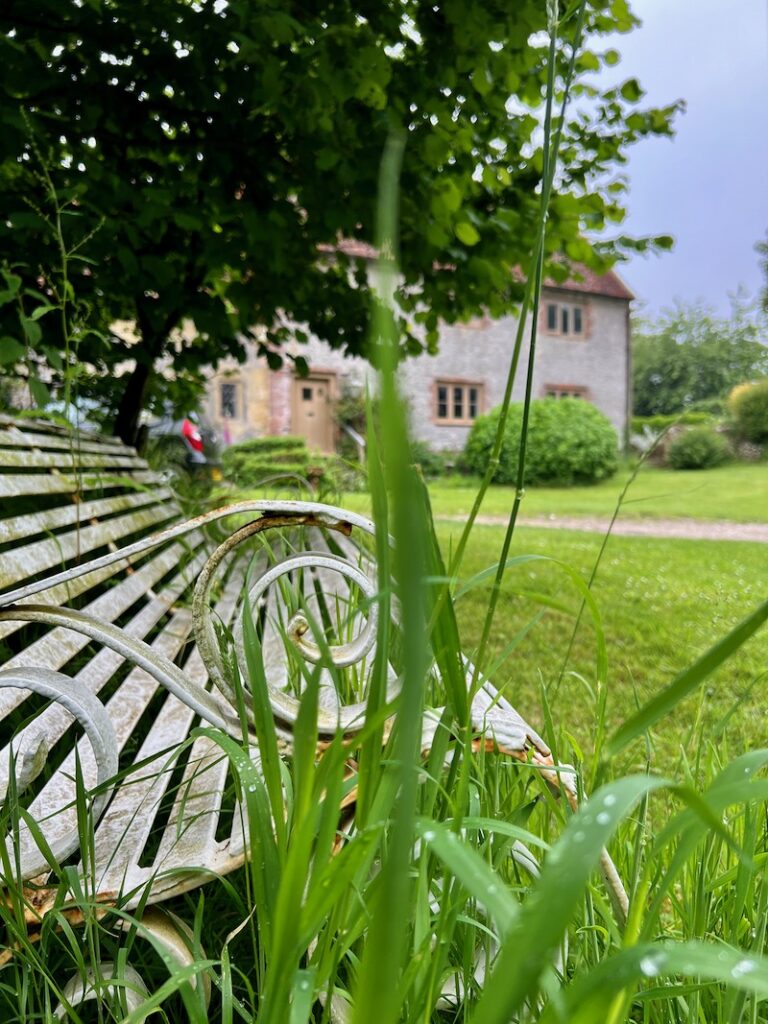
from the garden
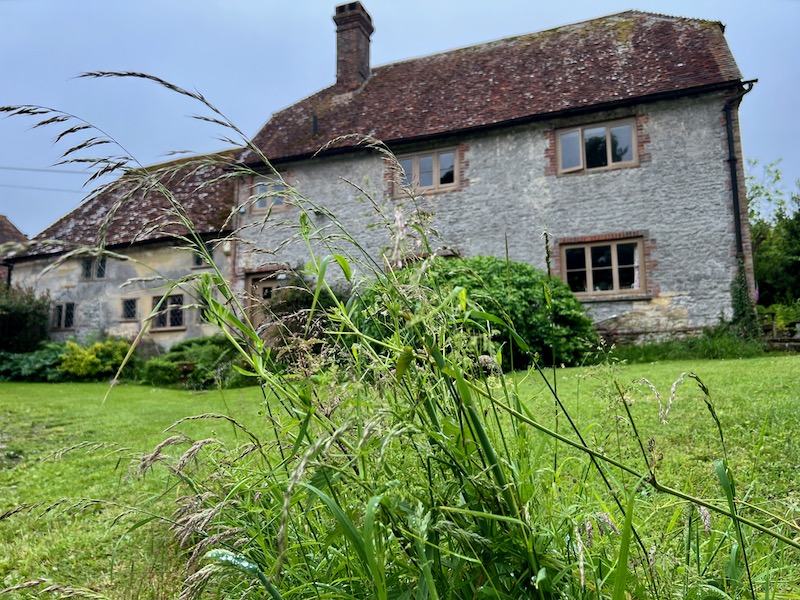
‘It’s very unusual to find a house which has been lived in this long and not altered. ‘
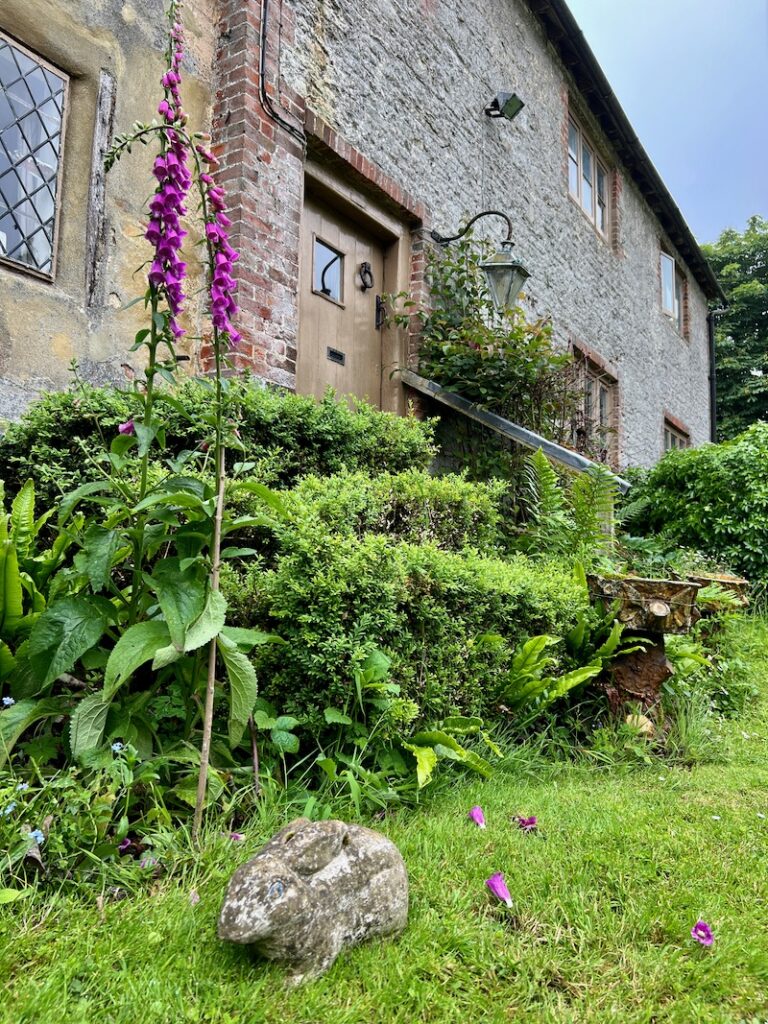
rabbit
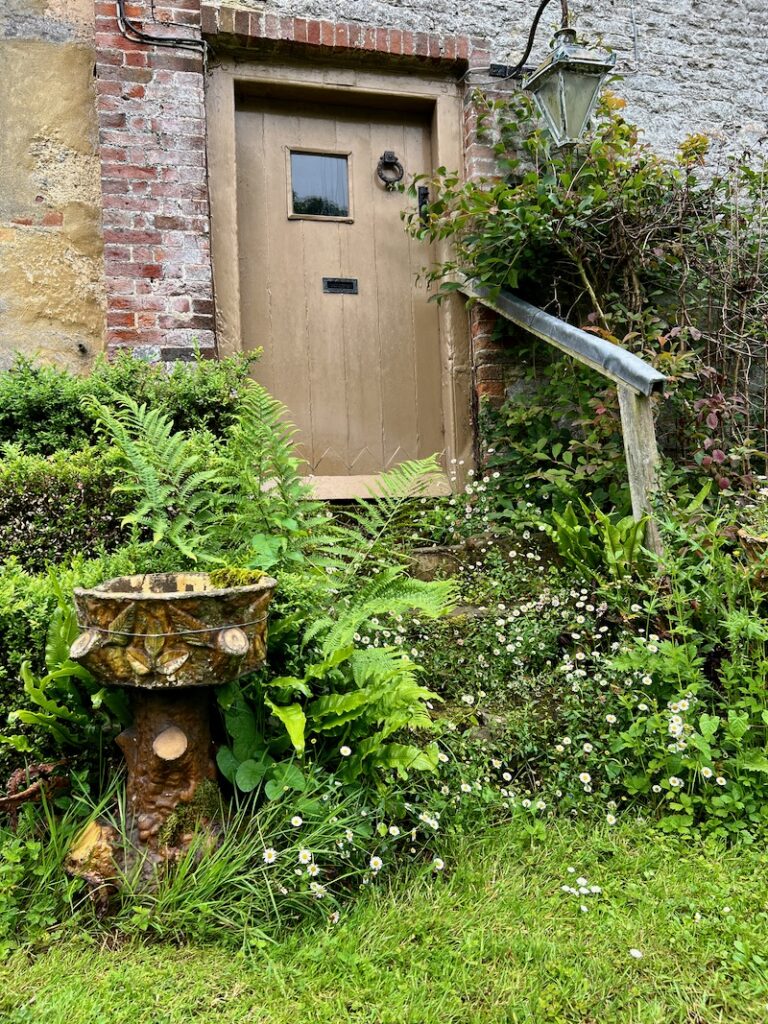
Mexican daisy
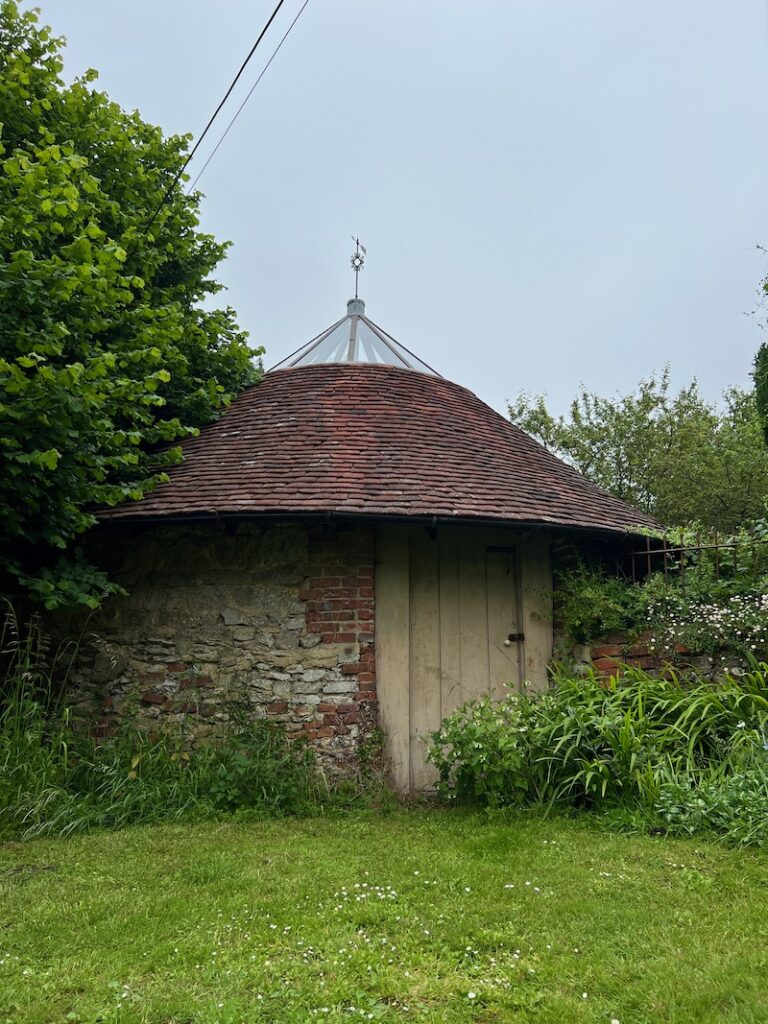
‘A man in the village came round and said – You mustn’t destroy that, that’s a Tudor dovecot!’ Until the war it was the village cider press, then the roof caved in and when we came it was full of trees.’
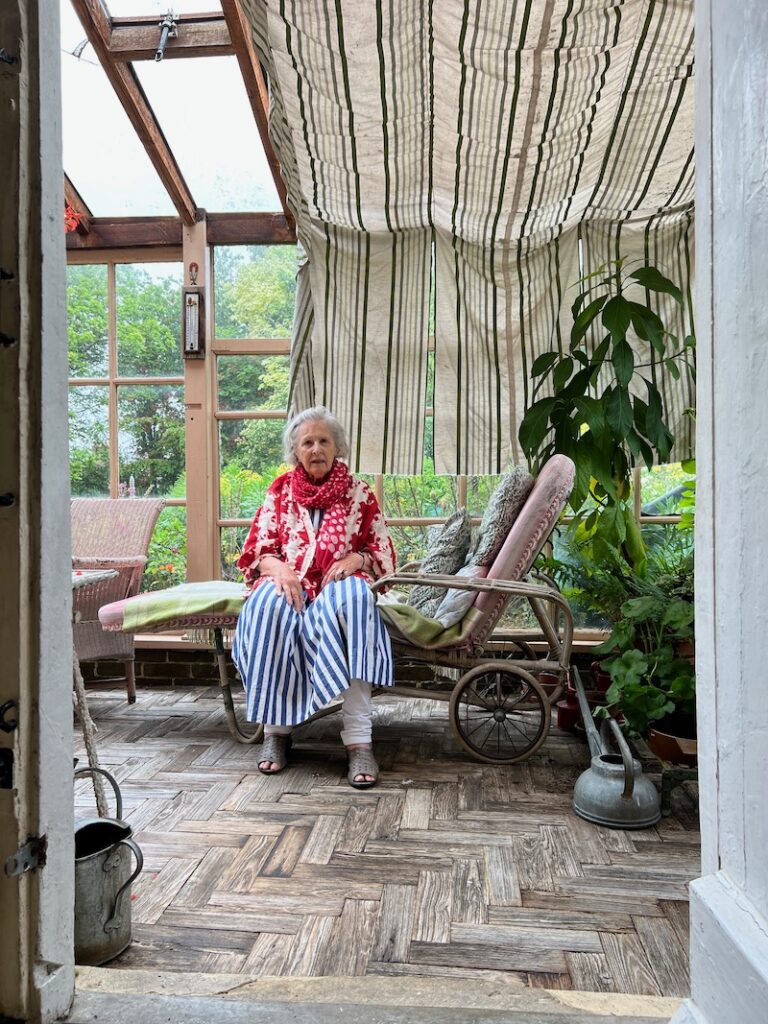
‘Cut off the legs and paint it white – That was the secret to everything in the 60s.’
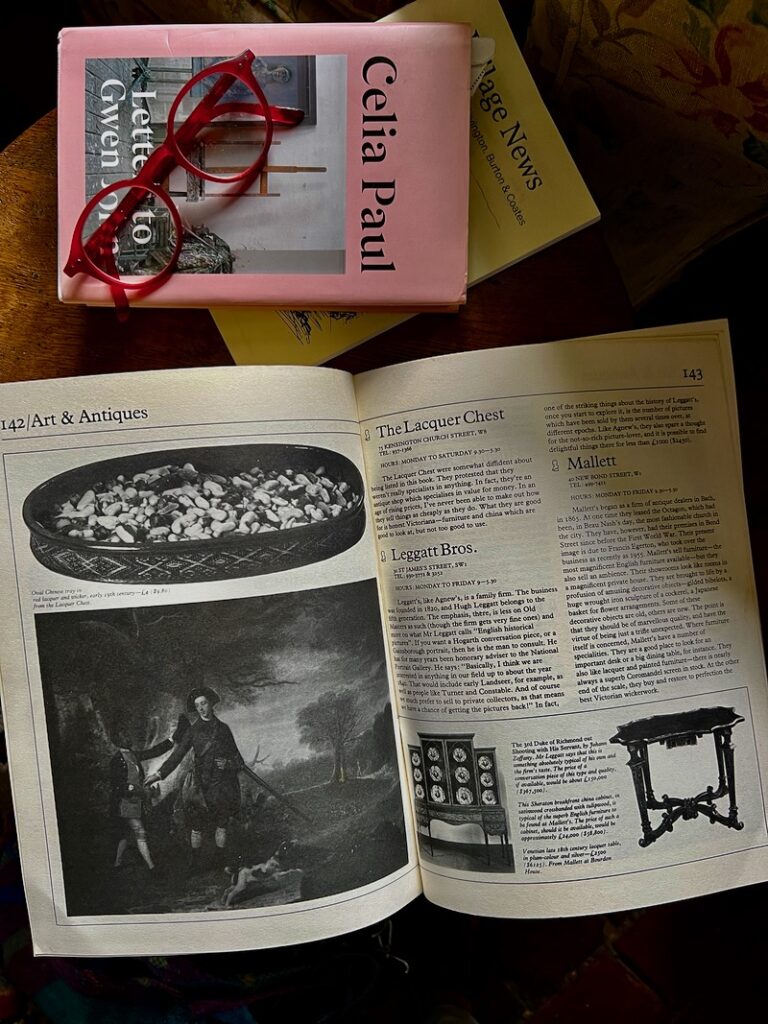
The Lacquer Chest – advertorial back in the day
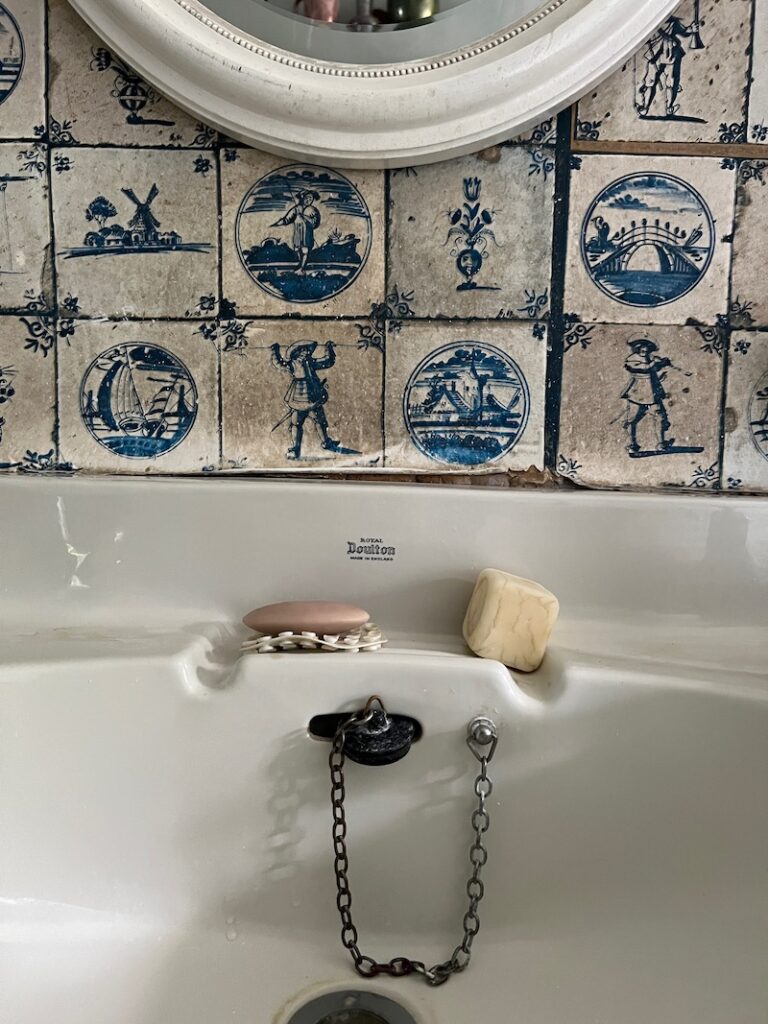
My favourite Fablon shot and ….
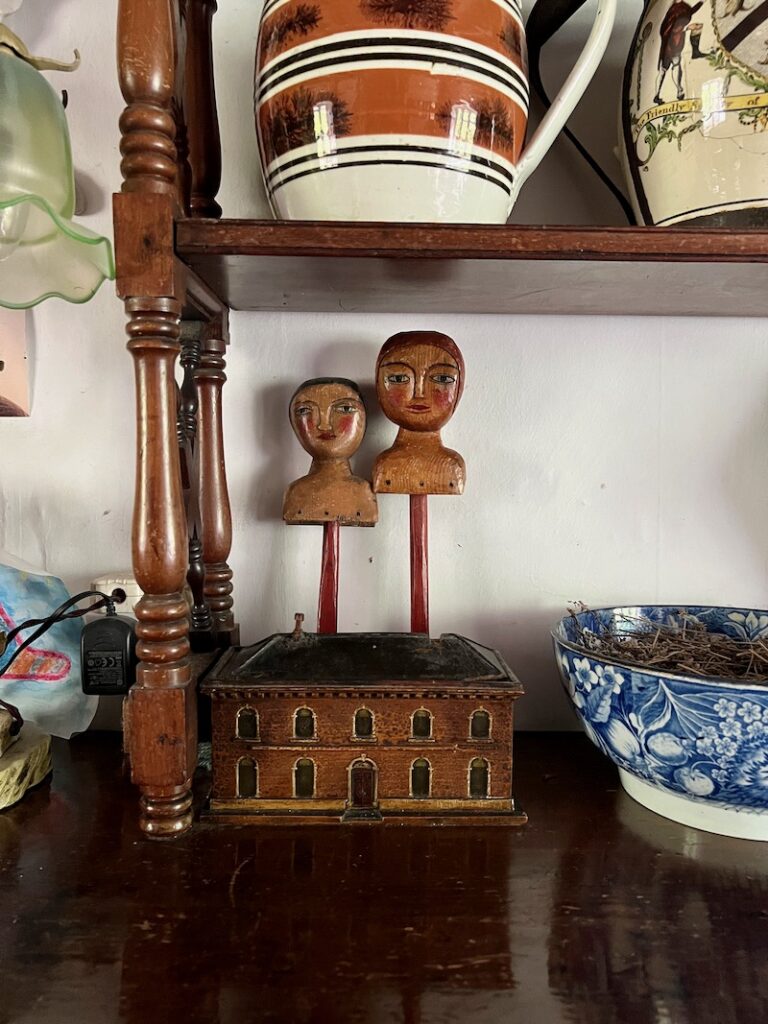
My other favourite shot…
Very many thanks to Gretchen Andersen and Emily Andersen. All photographs copyright bibleofbritishtaste. Excerpts may be used as long as clear links are supplied back to the original authors and content.

This astonishing house requires hours of study! Thank you!
What an eye. What a life.
Surely someone will start making those stick on tiles again
I have many lovely things acquired in the 70’s from Gretchen. Still love ‘em. Especially a magpie painted on silk.
More than wonderful
Fabulous . Love everything about this story. Thank you .
I have two full rolls of the blue and white stick-on Delft tiles, one has bigger tiles than the other. One is in the original packaging sent to my mother many decades ago.
Maybe I will use it yet!
Thank you…. This is a wonderful house and a lovely article… has made my Sunday
How can seeing pictures of a house in a country I’ve never visited thrill me so much? Thank you for sharing it with us.
I know about Gretchen and The Lacquered Chest from my mum who was best friends with Cornelia Bailey who worked there in the 60s/70s? You should do a piece on her too, her house Plas Teg in wales is a Jacobean mansion she restored, when she bought it there was a tree growing up through the great hall! It’s a wonderful place and she did it up with her bare hands! It would be a shame not to record it and I think it’s right up your street! Thanks for this article, Gretchen is such an inspiration!
Wonderful house and home full of character and style, thanks for these lovely photographs.
I dream of dear old houses like this, makes my body and mind so relaxed. Thank you.
What was in the window? Could only mean one shop after a trip down Kensington Church Street. Always inspirational, quirky and covetous. I will thank you tonight when we sit at our kitchen table bought from L. chest in 1974 and carried up Church Street to Linden Gardens by it’s new owner and friend.The top provided shelter from the rain!
From Sydney, Australia, I have just emerged from the magical rabbit hole that is Gretchen’s family home … frayed textiles, worn floors, peeling paint, loved collections, all embraced in a still-standing muddle of stones, rocks and tiles. An absolute treasure of a person and place.
On Caroline Hofbrucker’s (above) recommendation, I came to this website and have had such a wonderful time being taken on a tour of your fascinating home, Gretchen. Emily, I love your photography, and the picture taken in 1987 of your parents, and I’m presuming yourself and your brother, is a really clever, creative way of composing a family portrait. It says so much about your family’s imaginative way of approaching things. So many interesting images to explore … I particularly loved the Tudor dovecot – never seen one before, and such a size! And the glass paintings – fascinating. And the paintings salvaged from the sooty basement – wonderful! I could go on … Thank you to all involved in creating this piece.
What a wonderful house.I remember the shop on Church street well.I worked at 19-21 Church St at “Take 6” and still have a lovely pair of hall chairsI purchased from them in the 70’s and many other bits . I loved the cozy coal fire in the
room at the very back of the shop on a cold gloomy winters day.Thanks so much for sharing your home
I will be re-reading this article numerous times, soaking it all in. What a treasure!
I found this gift this morning and it brought joy and energy to the day. Thank you.
I had been waiting and waiting for something superb, and you have delivered it to me. Bless you.
I have the worst case of dish-envy now. Those china cupboards and shelves!!!
Thanks to this article I am now thoroughly enjoying Celia Paul’s book Letters To Gwen John.
dear Ruth, I discovered your site this summer, following various links to Min Hogg, given that WOI is a pale imitation of the richness she brought to that monthly package of wonder and delight.
I’m just overjoyed that you do the bible of British taste, a slightly tongue-in-cheek title as it is such an eccentric taste, but one that makes so much beauty out of inherited things, junkstore finds, found in skip things, bought by mistake things: it all gets mixed in a peculiar, dusty, layered, dim roomed way that means one’s past is never jettisoned, just rearranged a bit to keep up with one’s present self.
thank you so much for the pleasure you have brought to so many of us, in far-flung places where we never, ever, see such casual brilliance.
all the best,
Stephanie
How delicious! I, too, had some of the stick-on tile paper, wonderful stuff.
Overwhelmingly wondrous. Too much to absorb in one go. I’ll be Bach. Thank you all. My day is made.
Ive explored this unique woman’s unique property before theough your site and one or two articles. I cant get enough. Its just a magically real, full-of-creative life home. The fact that she and her husband respected the bones enough to live with less than current amenities, or maybe they didnt care, let it just be. Then filling it with all these beautiful and useful things that others were tossing. Unique is over used and not rich enough to celebrate her cthank you for appreciating it and allowing us to share a smidgen of it.
Your articles are so wonderfully absorbing and inspiring. I could spend hours browsing through the stories about these lovely houses and their owners. Thank you!
Thank you for sharing this wonderful house of memories. I’m now inspired and have justification to keep my battered old easy chair in the snug. It’s by far the most comfortable in the house, and it’s been loved and used for over 40 years. I realise now that I don’t need a new one, because I love this old one just like the faux delft tiles. Remarkable.
Thank you for sharing this treasure filled with more treasures.
My late husband and I loved going to The Lacquer Chest – what fabulous memories we have of Gretchen and Vivian.
Thank you. Thank you.
I used the same stick-on Delft tile paper in my summer cottage bathroom in the 1970s! “Great minds run in the same channels,” as they used to say.
Really lovely! I enjoyed the house and the garden!
Thank you above everything for not having those awful things that shut us out. COOKIES. I have a tiny cottage and many beautiful things, mainly natural wood, but how do you keep it so organised.? I too have brick floors. All my neighbours in similar cottages have modernized by knocking out the back doors and windows but I won’t do it. My 10′ square main room is dark, but warm and cosy in the winter. It’s absolutely chocker block with text books, candles and bless it, dark brown furniture gathered from the local tip. I love living the old way. Character and Soul. Xxx
I worked at no. 50, for Gordon Savage at Phillips & Page in 1967/8 before going solo. The owner, John Page-Phillips was a dilettante antiquarian and Gordon was his manager and real-time link with the trade. I remember Gretchen and Viv very well and the treasures to be found down the street at the Lacquer Chest. ‘Ken Church Street’ was full of great dealers: Jonathan Phillips of Phillips & Harris traded in fine furniture almost next door to us and A&J Speelman traded in Asian antiques on the other side; the wonderfully knowledgeable Eila Grahame was neighbour to Charles Howard at Vita Juel; those early dealers in Art Nouveau, John Jesse, and the pottery king, Richard Dennis were magnets for the trendy 60s young; Tristram Jellinek and his partner Antoine Vermoutier dealt in Antique European ceramics and early English pottery in their tiny shop just off ‘the street’ – not far from Marchants on the other side, still trading, who were dealing in oriental porcelain when invoices for shipping to the USA could not mention the word “Chinese” because China was not recognised by the States. Joe Gordon and Tony Cooper, were down at the Notting Hill end of the street; and John Macmillan with his great breadth of knowledge, taste and unerring commercial instinct was in the middle. We all traded with each other and there in the middle was the Lacquer Chest with its eclectic and quirky aesthetic, always welcoming and adept at appreciating the beauty and worth in stylish objects of all periods, even if damaged or neglected. Well done Gretchen and Viv for continuing that tradition in the sympathetic and beautiful life-support you have given to your stunning house.
Yes I have wonderful memories of all the dealers for whom I did and do chair caning for on Church St. They were and are a fascinating bunch and oh the stories
I have just stumbled across this article by accident. What a lovely read. I grew up in the village and my family are still there. Mr Francis who fell off his bike was our neighbour (we moved into one of the council cottages in the early 70’s when i was a child and my Father gave up his job on the farm, and therefore our tied cottage) and Mr Clare grew amazing dahlias !
I remember the Andersons well.
The house is currently on the market. I do hope whoever buys it treats it kindly.